Lancastrian Esses Collar
Lancastrian Esses Collar is in Livery Collars.
The Lancastrian Esses Collar first appears in the later 14th Century. Its is believed to represent the last words of his wife Blanche Plantagenet Duchess Lancaster "Souveyne vous de moi" or "Don't forget me". The earliest example being seen on the tomb of John Swynford in Spratton, Northamptonshire, dated to 1368.
On 12 Sep 1368 Blanche Plantagenet Duchess Lancaster (age 23) died at Tutbury Castle, Staffordshire [Map]. Her last words were said to be "Souveyne vous de moi" ("Don't forget me") the 'S' of which was possibly subsequently represented on the Lancastrian Esses Collar. She was buried at St Paul's Cathedral [Map]. Her son Henry IV King England (age 1) succeeded 3rd Earl Derby and 6th Earl Lancaster.

On 25 Feb 1387 John Grey aka Marmion (age 44) died in Spain. In 1400 Elizabeth St Quentin (age 53) died.
Monument in St Nicholas Church, West Tanfield [Map]. Camail and Jupon Period. Lancastrian Esses Collar. Hip Belt. Feathered Crest on Great Helm. Angels Supporting Pillow. His bascinet has decorated edges with the camail appearig to attach inside the bascinet. Decorated flat band. She wearing a unusual headress which appears to be a cross between Gabled Headress and Bongrace. Her dress long with a Low Rounded Neckline and appears to be decoated with an armorial: vair at the top, chevrons at the bottom, which may be  Marmion Arms or a variation of.
Marmion Arms or a variation of.
John Grey aka Marmion: In 1343 he was born to John Grey 1st Baron Grey and Avice Marmion Baroness Grey Rotherfield. Before 25 Feb 1387 John Grey aka Marmion and Elizabeth St Quentin were married. He a great x 4 grandson of King Henry "Curtmantle" II of England.
Elizabeth St Quentin: Before 1347 she was born to Herbert St Quentin and Mary Lisle.
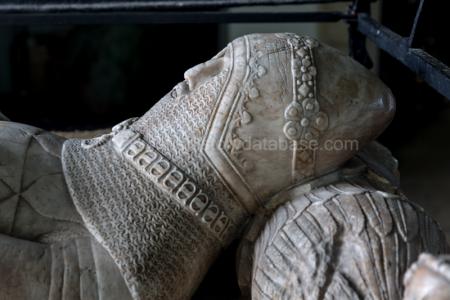
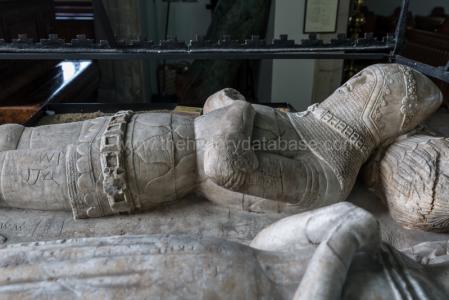
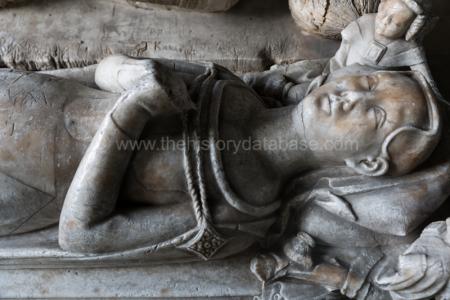
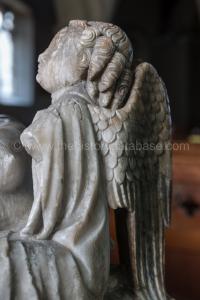
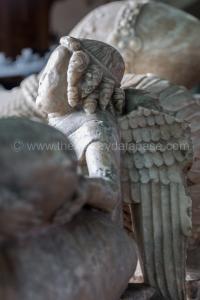
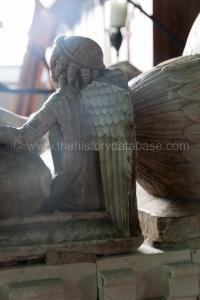
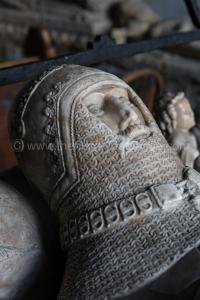
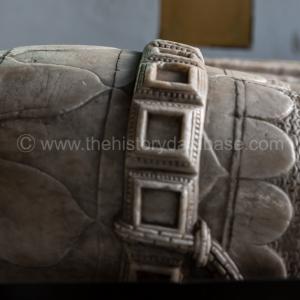
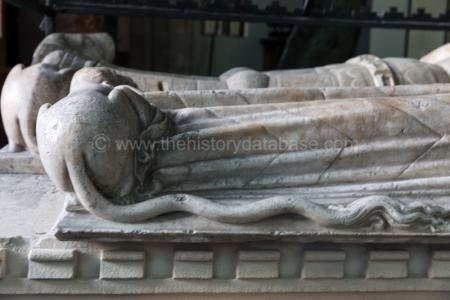
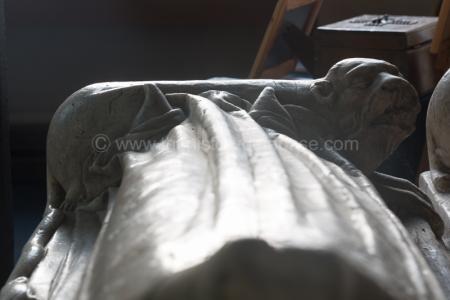
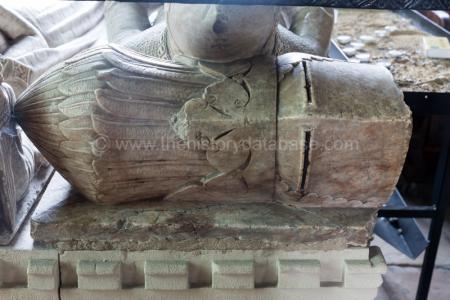
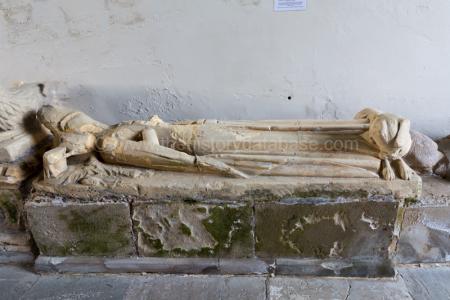
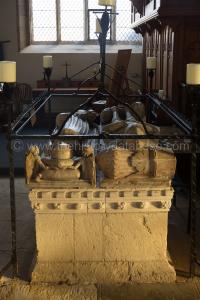
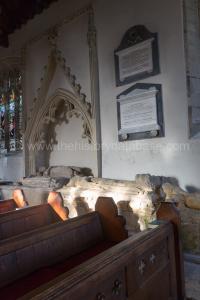
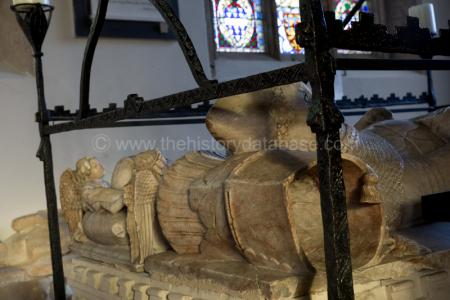
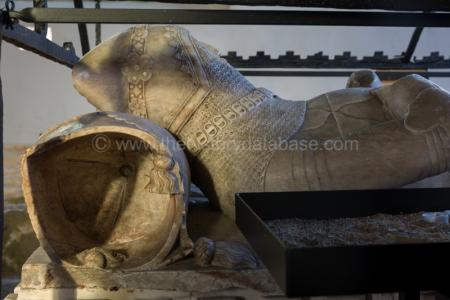
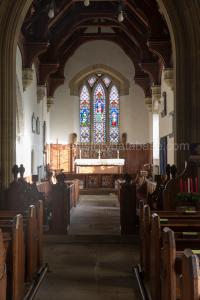
In 1389 Robert de Fouleshurst (age 59) died. He was buried at St Bertoline's Church, Barthomley [Map]. Camail and Jupon Period. Chest with Angels with Rounded Wings holding Shields. Hip Belt. Lancastrian Esses Collar. IHC NASARE Lettering.
Robert de Fouleshurst: Around 1330 he was born. Before 1366 Robert de Fouleshurst and Elizabeth de Praers were married.
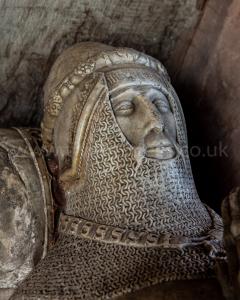
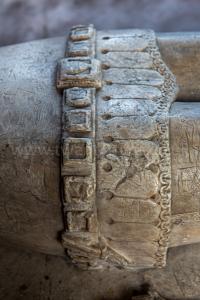
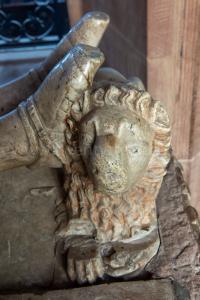
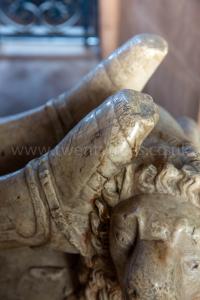
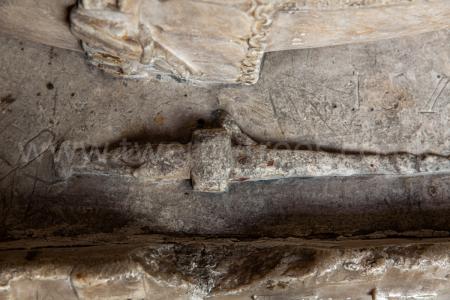
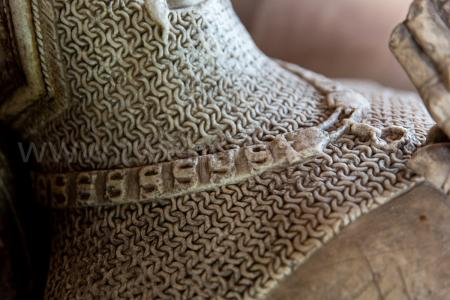
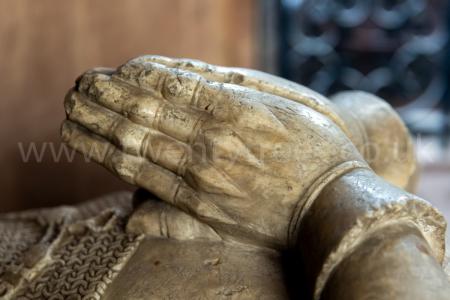
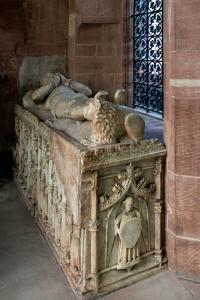
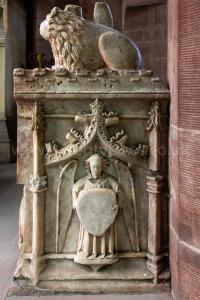
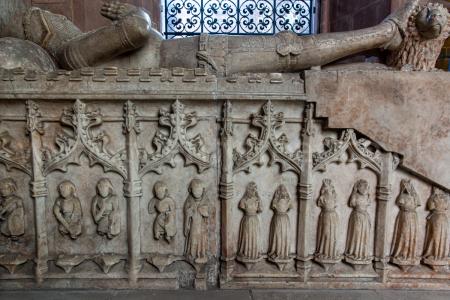
In 1399 William Mainwaring (age 54) died. He was buried at St Mary's Church, Acton [Map]. Monument Early Plate Bascinet and Gorget Period. Lancastrian Esses Collar. Ass's Head Crest. Orle.
William Mainwaring: Around 1345 he was born to William "The Elder" IV Mainwaring in Over Peover.
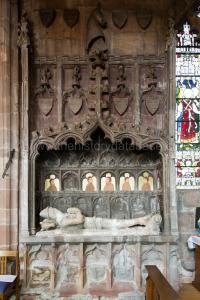
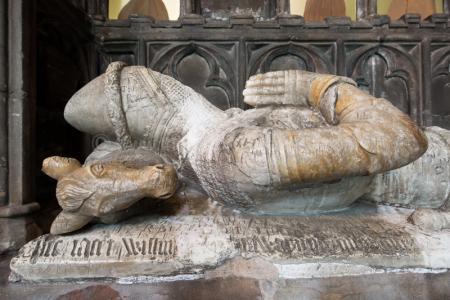
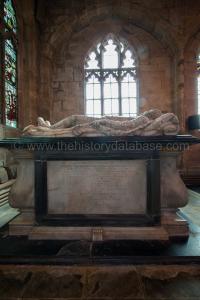
After 31 Aug 1401. St Chad's Church, Longford [Map]. Monument to Nicholas III Longford (deceased). Lancastrian Esses Collar. Camail and Jupon Period. Curious helm crest which at first sight appears to be surmounted with three mushrooms but on closer inspection is a Feathered Crest; the Longford Crest.
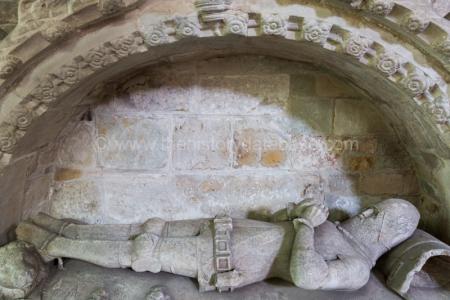
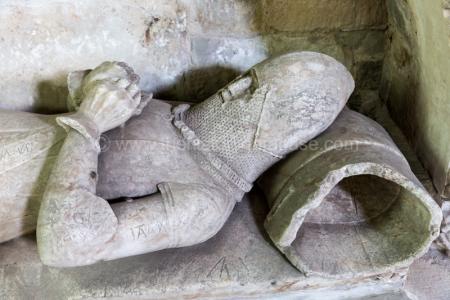
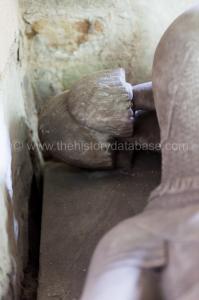
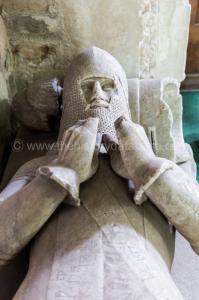
After 21 Jul 1403 Thomas Wendesley (age 59) was buried at All Saint's Church, Bakewell, Derbyshire [Map]. Camail and Jupon Period armour. IHC NASARE Lettering. His Coat of Arms just visible. Lancastrian Esses Collar.
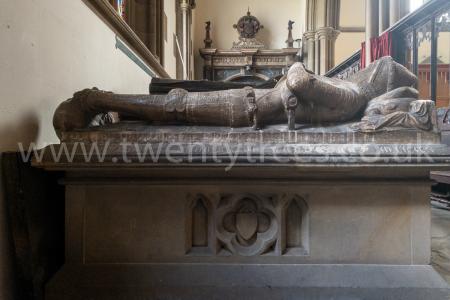
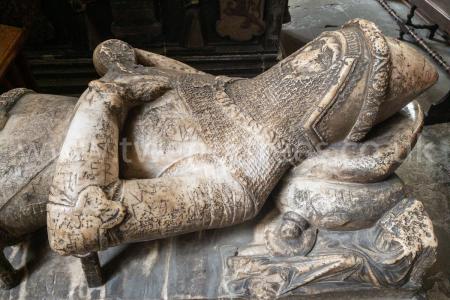
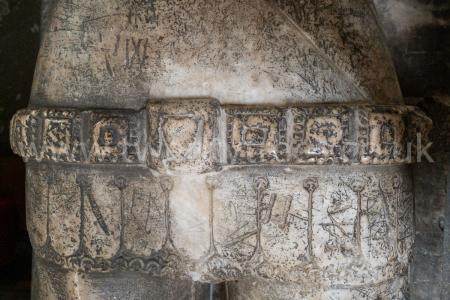
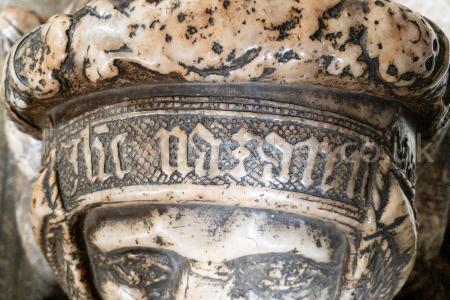
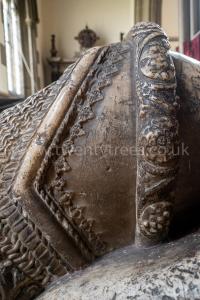
In 1406 John Curzon died. Monument in All Saints Church, Kedleston [Map]. Fluted Period. Lancastrian Esses Collar. Reset in tomb recess with depressed crocketed and pinnacled ogee arch, with shields above. This effigy is somewhat anomalous being much earlier than other Fluted Period effigies. It may have been decades after John Curzon died, or may be a mis-attribution, or the effigy may have been placed into the arch from another monument at a later date.
John Curzon: John Curzon and Eleanor Twyford were married. he was born to Roger Curzon.
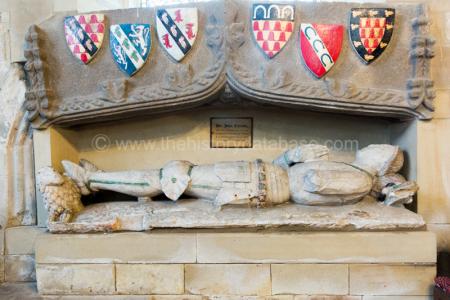
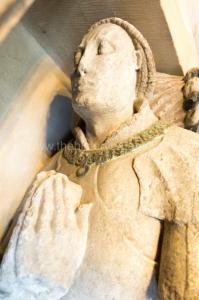
In 1410 John Mainwaring (age 66) died. On 06 Apr 1418 Margaret Stafford (age 73) died. Both buried at St Lawrence's Church, Over Peover [Map].
Monument at St Lawrence's Church, Over Peover [Map]. Camail and Jupon Period. IHC NASARE Lettering. Hip Belt. Lancastrian Esses Collar. Woman Esses Collar.
John Mainwaring: Around 1344 he was born to William "The Elder" IV Mainwaring in Over Peover. Before 1410 John Mainwaring and Margaret Stafford were married.
Margaret Stafford: Around 1345 she was born to John Stafford and Margaret Stafford.
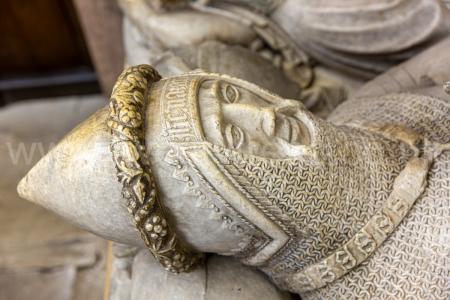
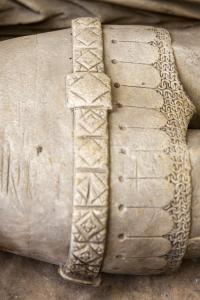
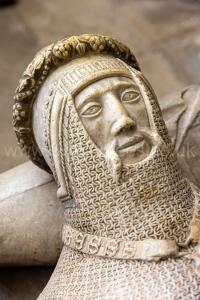
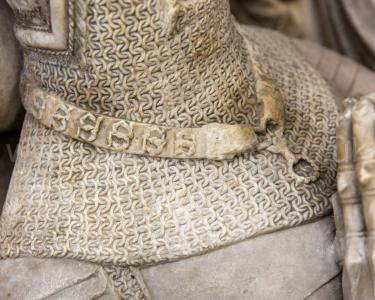
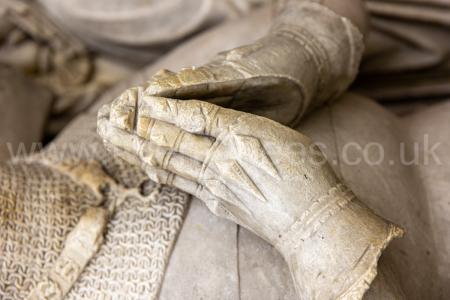
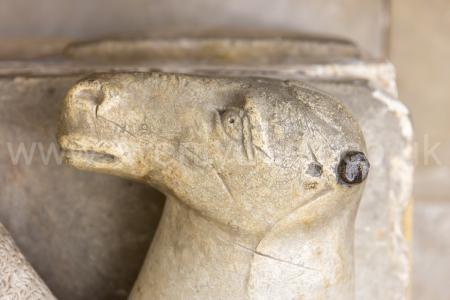
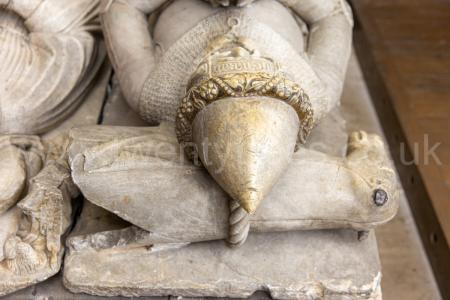
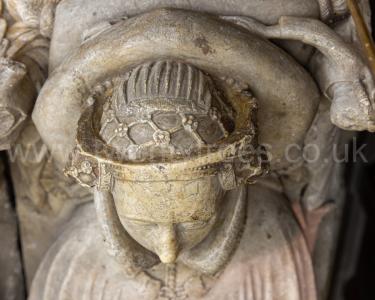
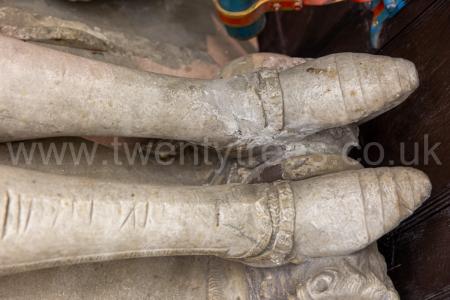
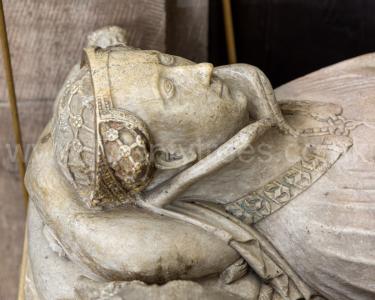
After 01 Sep 1414 William Ros 6th Baron Ros Helmsley (age 44) was buried at Belvoir Priory [Map]. At the dissolution of the monasteries his monument was moved to the Chancel of St Mary the Virgin Church, Bottesford, Leicestershire [Map] on the right side of the High Altar. Alabaster Monument of the Camail and Jupon Period. Possibly Sutton and Prentys.
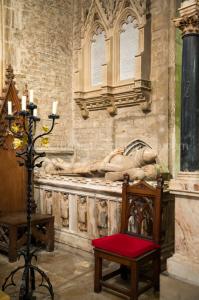
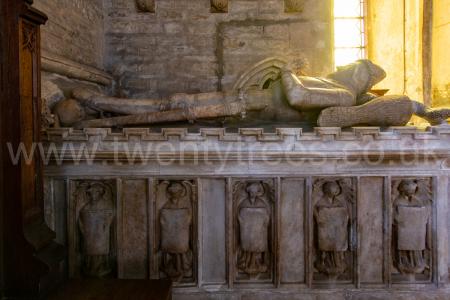
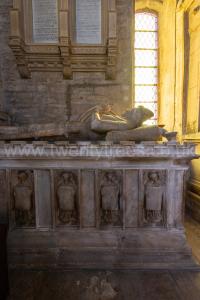 Chest with Angels with Rounded Wings holding Shields.
Chest with Angels with Rounded Wings holding Shields.
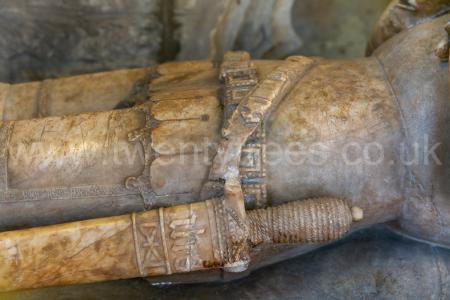 Scabbard with IHS. Wire Wrapped Grip. Hip Belt.
Scabbard with IHS. Wire Wrapped Grip. Hip Belt.
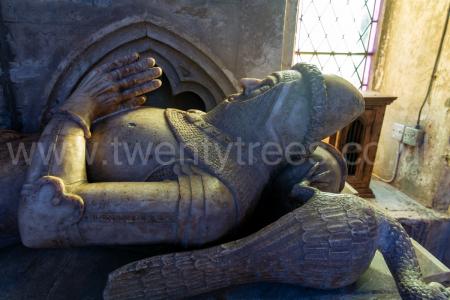
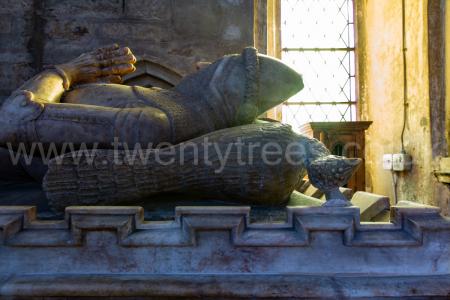
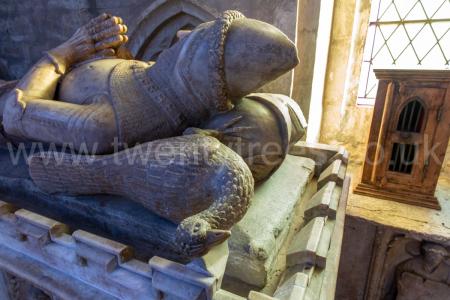 Detail of the Ros Family Peacock Crest surmounting his Great Helm.
Detail of the Ros Family Peacock Crest surmounting his Great Helm.
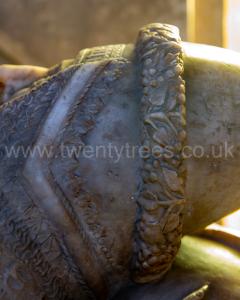 Detail of decorated Orle and Vervelle Cover.
Detail of decorated Orle and Vervelle Cover.
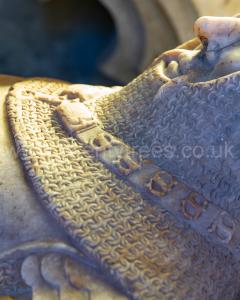 Detail of Lancastrian Esses Collar and face. Note the twisted moustache that is frequently seen on Sutton and Prentys monuments. The fixing of the Esses Collar to the Camail using a small trefoil.
Detail of Lancastrian Esses Collar and face. Note the twisted moustache that is frequently seen on Sutton and Prentys monuments. The fixing of the Esses Collar to the Camail using a small trefoil.
After 23 Mar 1421 John Ros 7th Baron Ros Helmsley (age 24) was buried at Belvoir Priory [Map]. His remains and monument were subsequently relocated to the Chancel of St Mary the Virgin Church, Bottesford, Leicestershire [Map]. Early Plate Bascinet Period.
John Ros 7th Baron Ros Helmsley:
Around 1397 he was born to William Ros 6th Baron Ros Helmsley and Margaret Fitzalan Baroness Ros Helmsley.
On 01 Sep 1414 William Ros 6th Baron Ros Helmsley died. His son John Ros 7th Baron Ros Helmsley succeeded 7th Baron Ros Helmsley.
Before 23 Mar 1421 John Ros 7th Baron Ros Helmsley and Margery Despencer 3rd Baroness Despencer, Baroness Ros were married. She by marriage Baroness Ros Helmsley. They were third cousins. He a great x 4 grandson of King Henry III of England. 

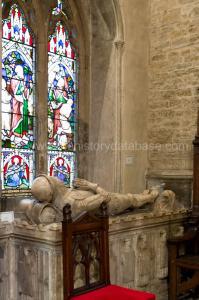
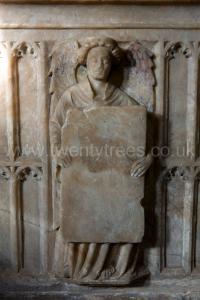
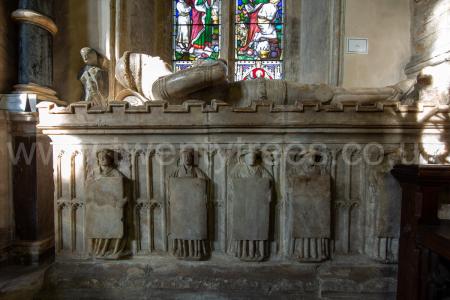 Chest with Angels with Rounded Wings holding Shields.
Chest with Angels with Rounded Wings holding Shields.
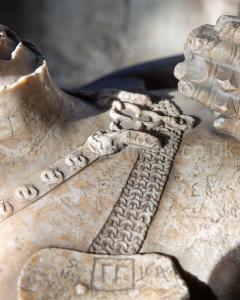 Detail of Lancastrian Esses Collar and the trefoil fixing holding the Lancastrian Esses Collar to the bottom of the Camail.
Detail of Lancastrian Esses Collar and the trefoil fixing holding the Lancastrian Esses Collar to the bottom of the Camail.
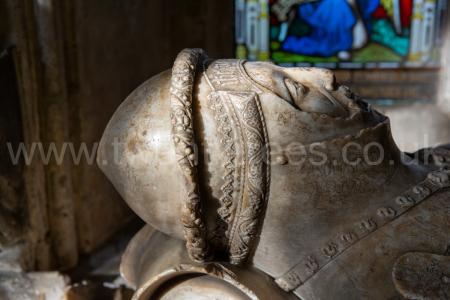 Detail of IHC NASARE Lettering and Decorated Orle and decorated Vervelle Cover. Bascinet with Gorget. Lancastrian Esses Collar.
Detail of IHC NASARE Lettering and Decorated Orle and decorated Vervelle Cover. Bascinet with Gorget. Lancastrian Esses Collar.
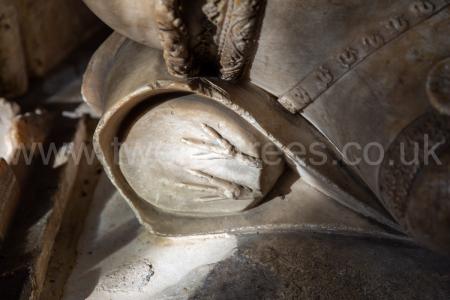 Detail of the Ros Peacock Crest which surmounted his Great Helm; only the feet remain.
Detail of the Ros Peacock Crest which surmounted his Great Helm; only the feet remain.
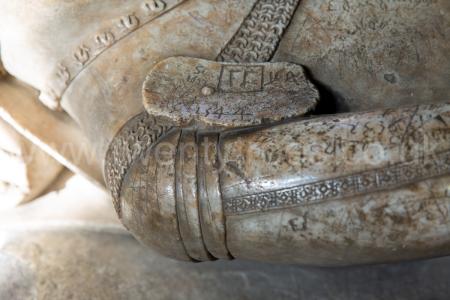 Detail of the Spaulder and Besagew with some early graffiti.
Detail of the Spaulder and Besagew with some early graffiti.
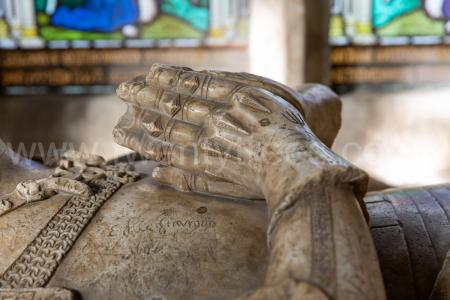 Detail of the Hourglass Gauntlets and graffiti.
Detail of the Hourglass Gauntlets and graffiti.
After 1423. St John the Baptist's Church, Tideswell [Map]. Thurstan de Bower -1423 and Margaret. Early Plate Bascinet and Gorget Period. Lancastrian Esses Collar. Basinet with decorated IHC NASARE Lettering. She wearing a Crespine Headress.
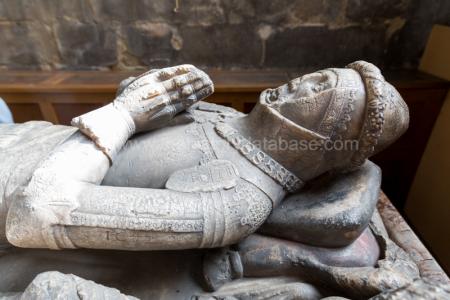

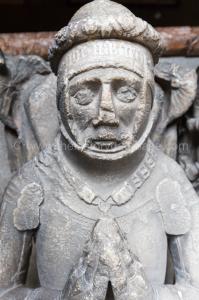
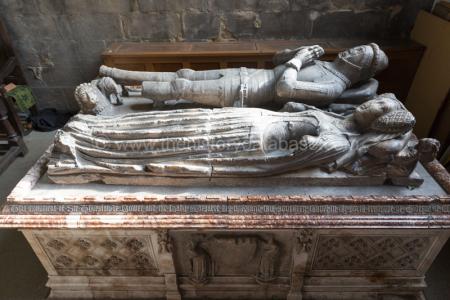
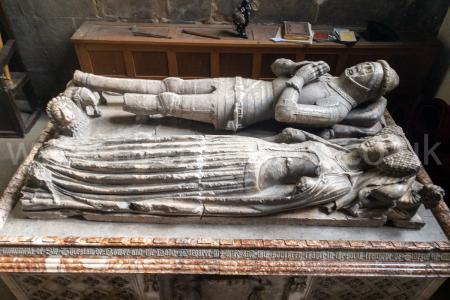
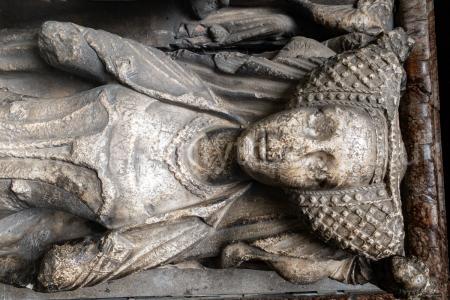
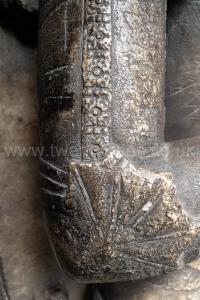
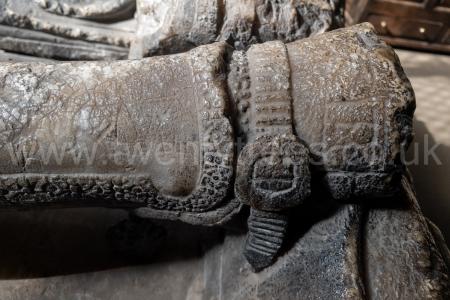
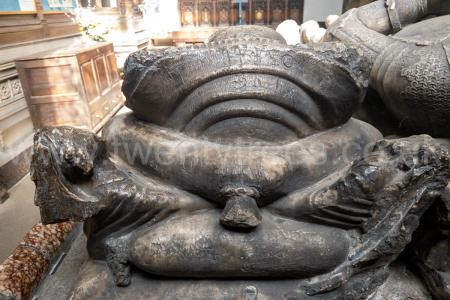
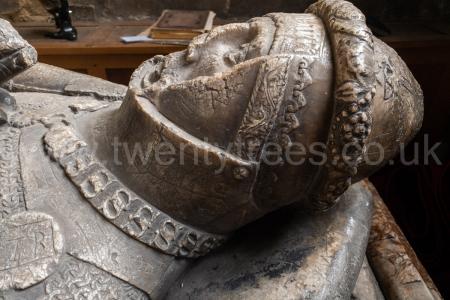
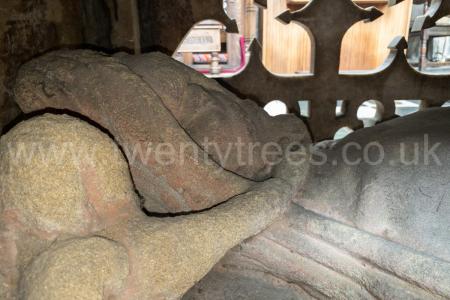
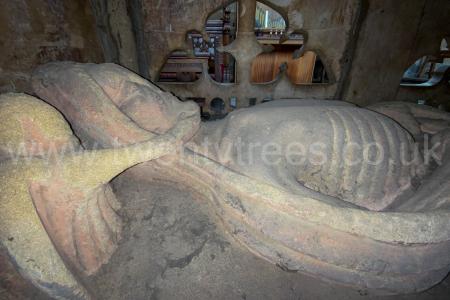
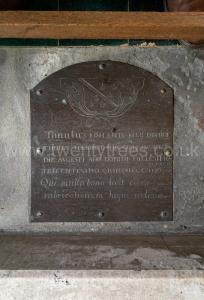
On 26 Feb 1432 Ralph Longford (age 31) died. St Chad's Church, Longford [Map]. Monument to Ralph Longford (age 31). Early Plate Bascinet and Gorget Period. Lancastrian Esses Collar. Hip Belt. IHC NASARE Lettering.
Ralph Longford: Ralph Longford and Margaret Melton were married. On 27 Oct 1400 he was born to Nicholas IV Longford and Sarah Harrington at Colwich, Staffordshire. He was baptised at St Peter's Church, Ellastone. On 19 May 1426, Whitsunday, King Henry VI of England and II of France was knighted by his uncles John Lancaster 1st Duke Bedford and Humphrey Lancaster 1st Duke Gloucester at Leicester, Leicestershire. Henry then went on to knight Ralph Longford, Thomas Courtenay 13th Earl Devon and Robert Wingfield.
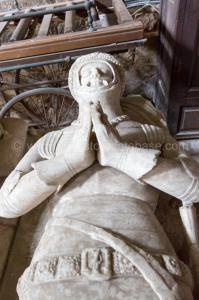
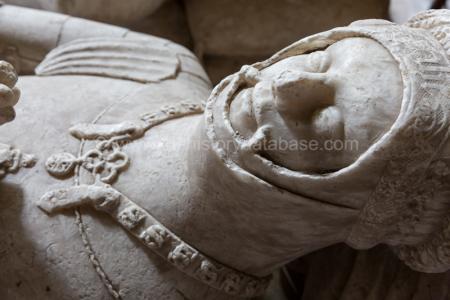
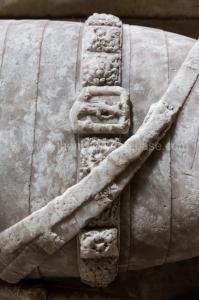
In 1435 Richard Delamere died, and Isabel his wife, died 1421. Monument in the North Transept of Hereford Cathedral [Map]. Figure of man in plate armour, feet on lion, figure of lady in horned headdress and SS collar, two dogs at feet, double canopy with cinque-foiled and sub-cusped arches and crocketted ogee gables and upper cornice, parts of standards and pinnacles missing, foot inscription and three shields-of-arms (a) Delamere, (b) the same impaling Acton.
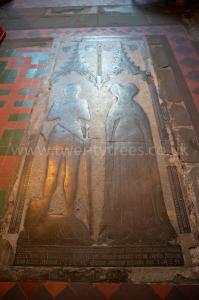
In 1436 John Greystoke 4th Baron Greystoke (age 47) died. He was buried at St Andrew's Church, Greystoke [Map]. His son Ralph Greystoke 5th Baron Greystoke (age 22) succeeded 5th Baron Greystoke. Monument in St Andrew's Church, Greystoke [Map]. Fluted Period. His Pauldrons are unusual in their style. His arms are fully encased in plate with a couter (or coude) protecting the elbow joint. Fine detail of the straps that held the armour in place may be seen on the underarms. A gorget, has replaced the camail. His head is, very unusually, bare as is his face, his hair cut in the style so typical of portraits of Henry V. The effigy was possibly made somewhat after John's death or, possibly, that the effigy has been incorrectly assigned. His head rests on the decorated tournament helm. He wears the Lancastrian Esses Collar. John had supported the usurpation of Richard II by Henry IV in the 1390s; staunch Lancastrians. John had married, in 1407, Elizabeth Ferrers, daughter of Joan Beaufort, daughter of John of Gaunt, son of King Edward III. Two sword belts: diagonal (bawdric) and horizontal. The jupon, beneath the waist has been replaced by a fauld; horizontal strips of metal that wrap around.
John Greystoke 4th Baron Greystoke: In 1389 he was born to Ralph Greystoke 3rd Baron Greystoke and Catherine Clifford Baroness Greystoke. On 28 Oct 1407 John Greystoke 4th Baron Greystoke and Elizabeth Ferrers Baroness Greystoke were married at Greystoke Castle, Cumberland. She by marriage Baroness Greystoke. She the daughter of Robert Ferrers and Joan Beaufort Countess of Westmoreland. She a great granddaughter of King Edward III of England. On 06 Apr 1418 Ralph Greystoke 3rd Baron Greystoke died. He was buried at Newminster Abbey. His son John Greystoke 4th Baron Greystoke succeeded 4th Baron Greystoke.
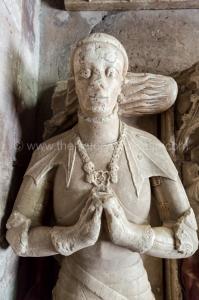
After 07 Jun 1438. Monument to John Cockayne (deceased) at St Oswald's Church, Ashbourne [Map]. Early Plate Bascinet and Gorget Period. Lancastrian Esses Collar. Cockerel Crest (most of which is missing). Horned Headdress. Chest with Angels with Rounded Wings holding Shields. Possibly Sutton and Prentys.
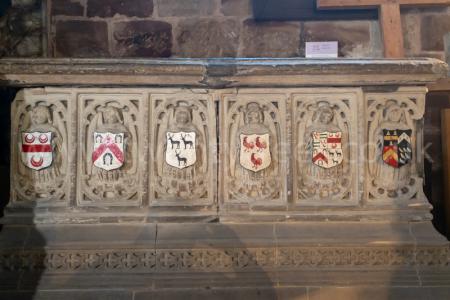
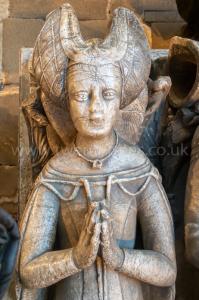
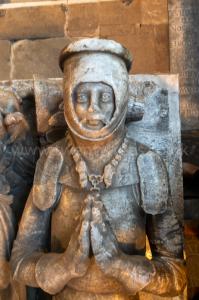
After 01 Oct 1440. Monument to William Rhyther (deceased) and Sybil Aldeburgh at All Saints Church Harewood [Map]. Early Plate Bascinet and Gorget Period. Lancastrian Esses Collar. Crespine Headress.
William Rhyther: In 1379 he was born to William Rhyther and Sybil Aldeburgh at Tadcaster, Yorkshire. On 01 Oct 1440 he died at Harewood.
Sybil Aldeburgh: Around 1363 she was born to William Aldeburgh 1st Baron Aldeburgh Harewood and Elizabeth Lisle Baroness Ferrers Harewood at Harewood. Around 1379 William Rhyther and she were married. On 03 Sep 1439 Sybil Aldeburgh died at Harewood.
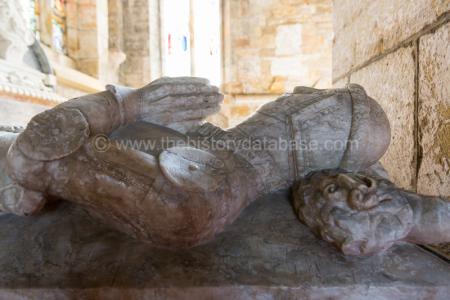
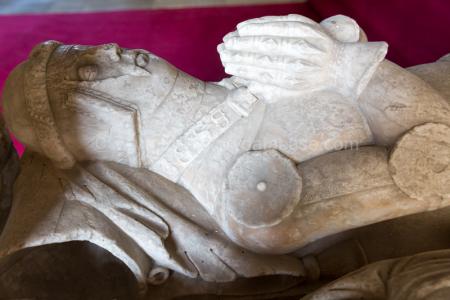
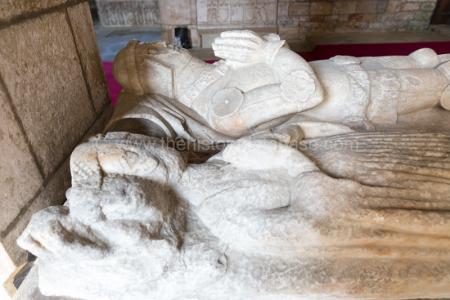
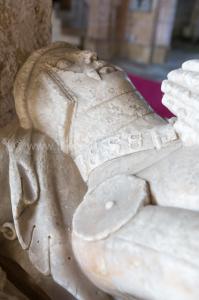
On 06 Jun 1441 William Phelip (age 58) died. He was buried at St Mary's Church, Dennington [Map]. Monument to William Phelip (age 58) and Joan Bardolf (age 50). Early Plate Bascinet and Gorget Period. Feathered Crest. Detail of the Wyvern on which her feet rest. Detail of Eagle, possibly hawk, on which his feet rest. Crespine Headress covering her hair. He wearing a bascinet with IHC NASARE Lettering. Both wearing a Lancastrian Esses Collar. Leg Garter below the left knee.
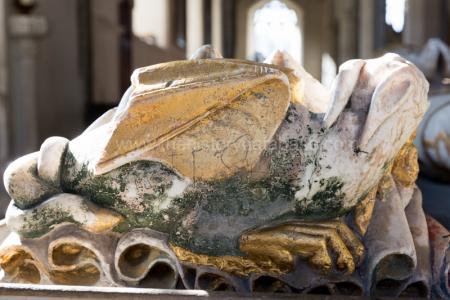
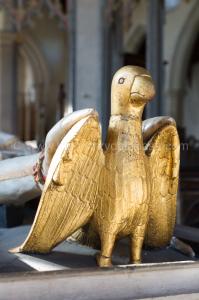
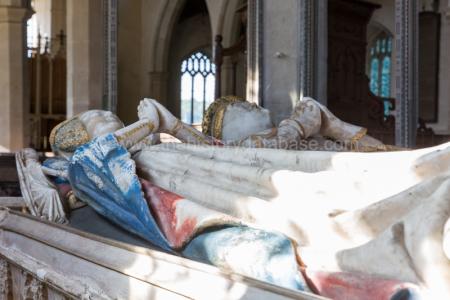
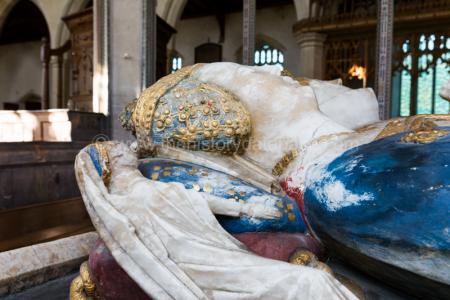
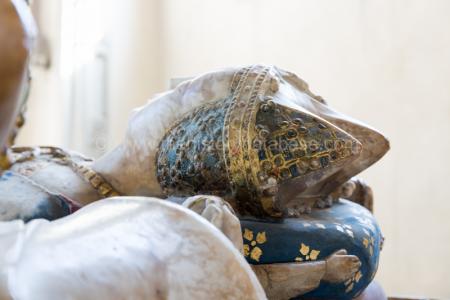
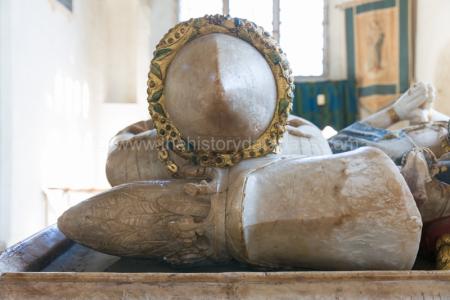
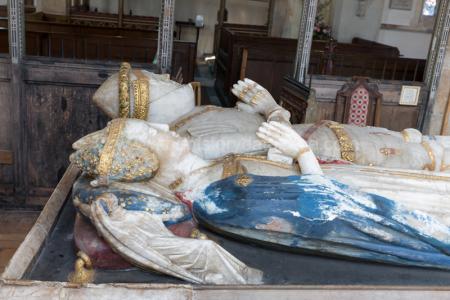
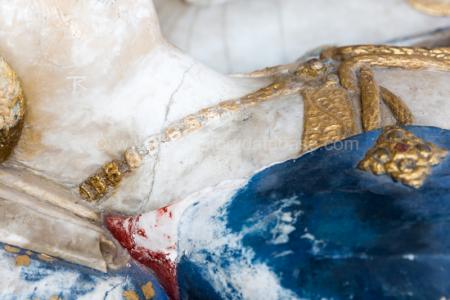
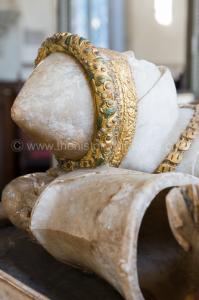
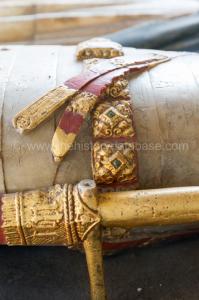
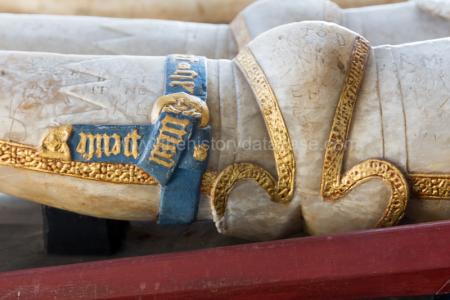
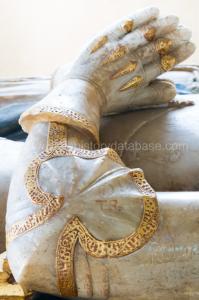
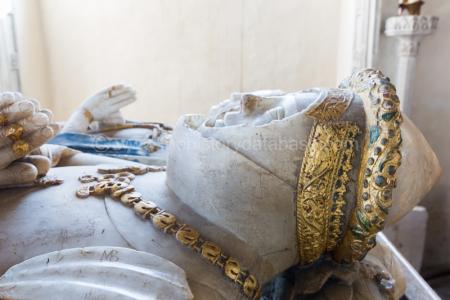
After 1443. St Peter's Church, Chillingham [Map]. Alabaster effigies of Ralph Grey and Elizabeth Fitzhugh on sandstone base. Fluted Period. Lancastrian Esses Collar.

Ralph Grey: In 1406 he was born to Thomas Grey of Werke and Heaton and Alice Neville. On 10 Dec 1427 Ralph Grey and Elizabeth Fitzhugh were married. She the daughter of Henry Fitzhugh 3rd Baron Fitzhugh and Elizabeth Grey Baroness Fitzhugh. He a great x 4 grandson of King Edward "Longshanks" I of England. On 17 Mar 1442 Ralph Grey died.
Elizabeth Fitzhugh: she was born to Henry Fitzhugh 3rd Baron Fitzhugh and Elizabeth Grey Baroness Fitzhugh.
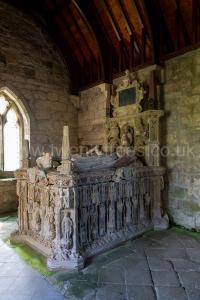
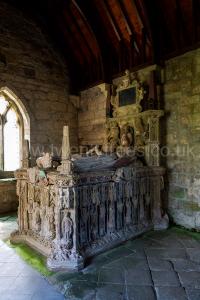
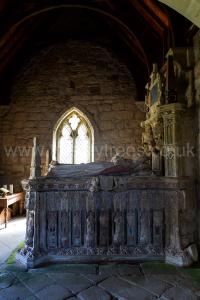
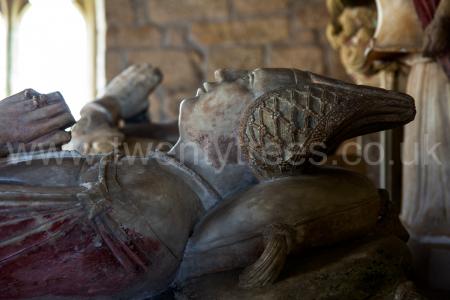
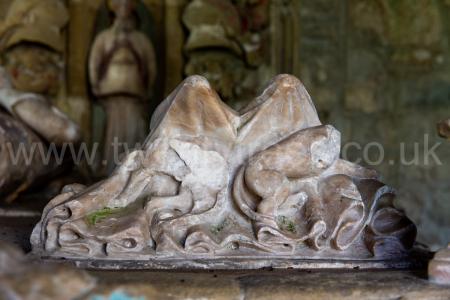
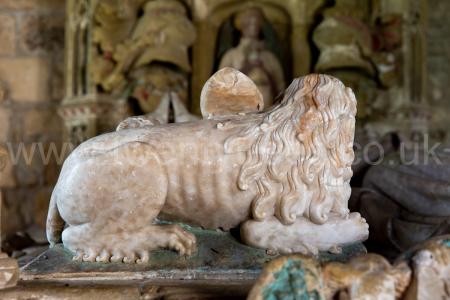
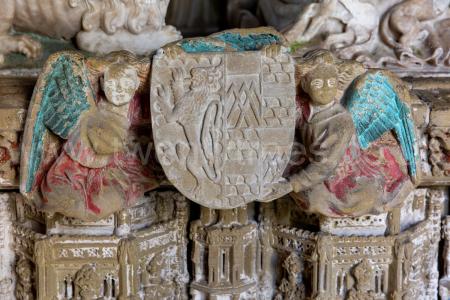
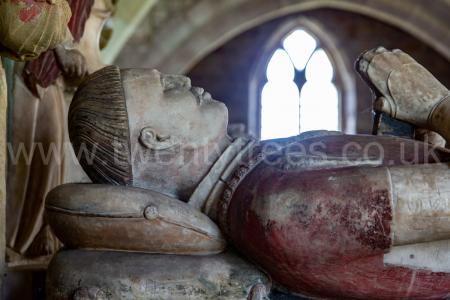
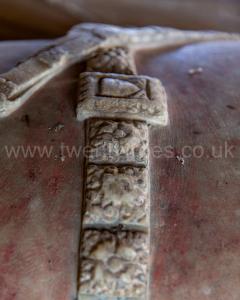
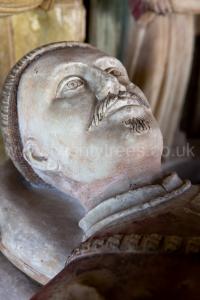
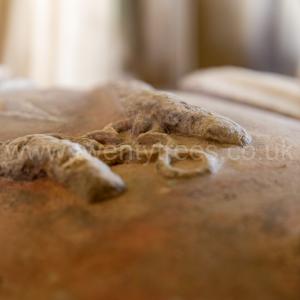
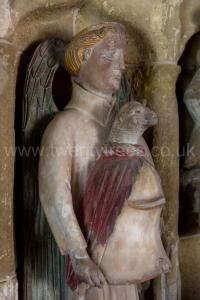
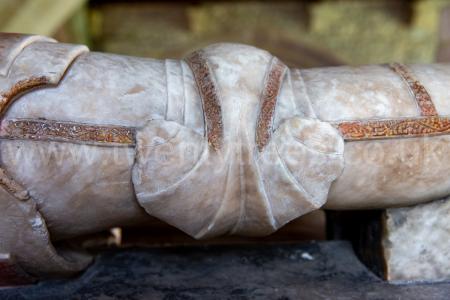
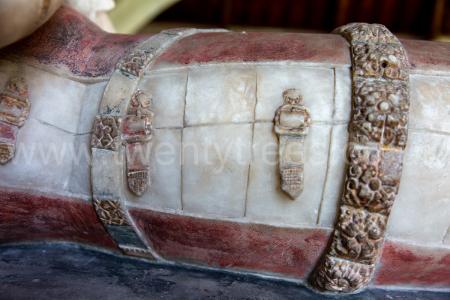
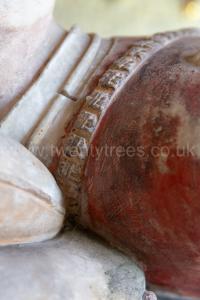
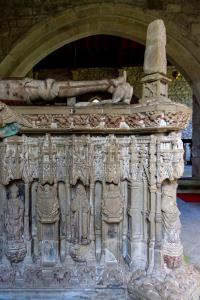
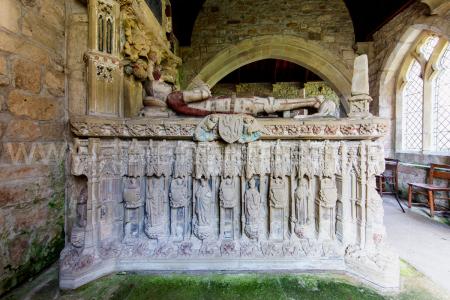
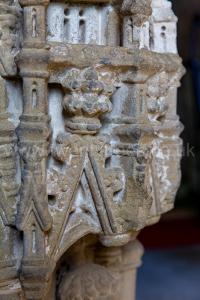
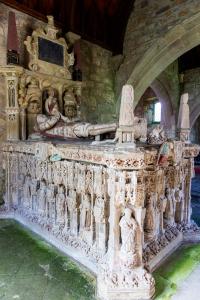
After 1451. St Bartholemew's Church, Tong [Map]. Monument to Richard Vernon aka Pembridge (age 62) and Benedicta Ludlow. Early Plate Bascinet and Gorget Period. He with an Lancastrian Esses Collar. Chest of sandstone with twenty-three niches containing, alternatively, twelve angels with shields, and eleven apostles. His head rests on the Vernon Horses Head Crest. She wearing Esses Collar and mitred Crespine Headress. Scabbard with IHS. Possibly the work of Sutton and Prentys.
Benedicta Ludlow: Shropshire Archaeological Society. And in addition, of our more abundant favour, we grant and give permission on our own behalf, and, as far as is in our power, on behalf of our heirs, to the aforesaid Isabel, Walter, and William Mosse, their heirs or assignees, that they themselves may give and grant the advowson and patronage of the aforesaid College, when it has thus been effectually founded, to Richard de Penbrugge, son of Richard Vernon, of Harlestonich, the near relative [Note. Richard Vernon aka Pembridge was great-nephew of Fulk de Pembridge of Tong Castle and heir of the the aforesaid Fulk, and to Benedicta, wife of the same Richard son of Richard, and to the heirs of the body of Richard son of Richard, and Benedicta, to be held, after after the death of the aforesaid Isabel, in such a way that if the same Richard son of Richard, and Benedicta die without heirs of their bodies, then the advowson and patronage of the aforesaid College remain with the heirs of the body of the same Richard son of Richard; and if the same Richard son of Richard die without an heir of his body, then the advovson and patronage of the aforesaid College remain with William Ludlow [Note. Son of William Ludlow and Isabel de Lingen] and Isabel his wife, sister of the aforesaid Richard, son of Richard, and the heirs of the body of the same William Ludlow and Isabel his wife; and if the same William Ludlow and Isabel his wife die without heirs of their bodies, then the advowson and patronage of the aforesaid College remain with the heirs of the body of the same Isabel, wife of William. Around 1391 she was born to John Ludlow and Isabel de Lingen at Hodnet, Shropshire. Before 1427 Richard Vernon aka Pembridge and she were married. In 1427 Benedicta Ludlow died at Tong, Shropshire.
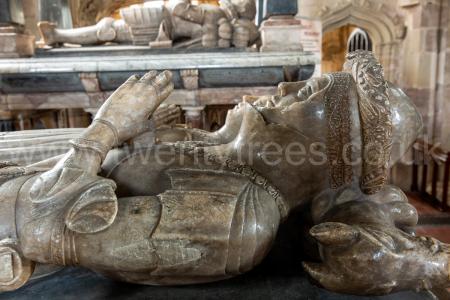
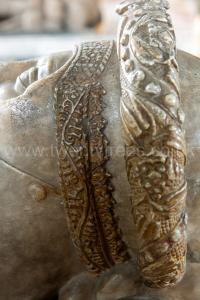
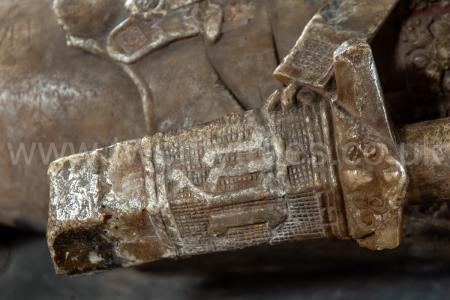
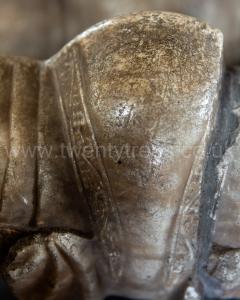
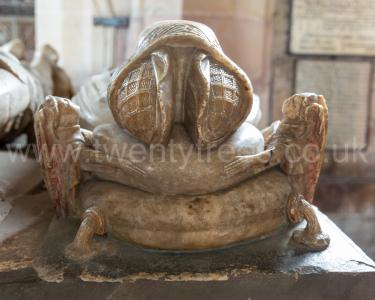
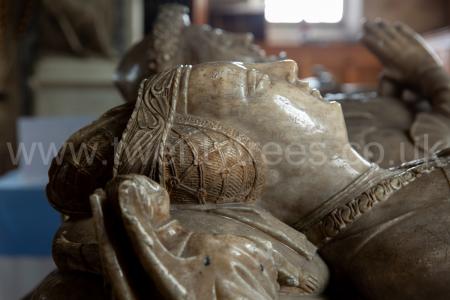
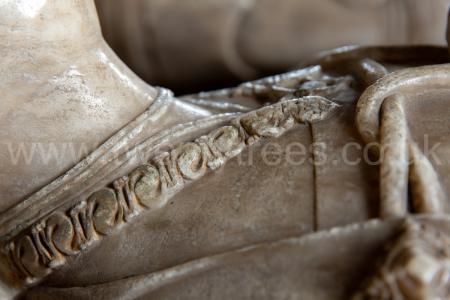
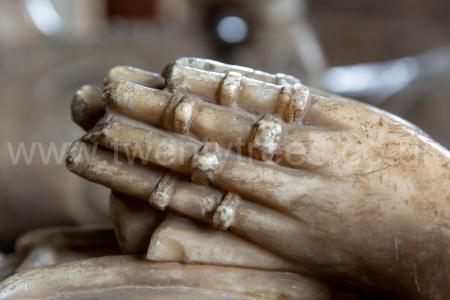
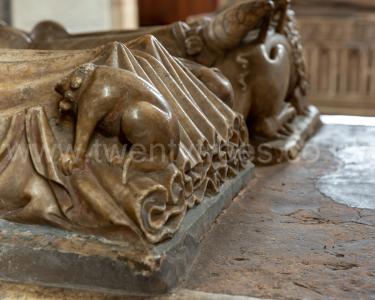
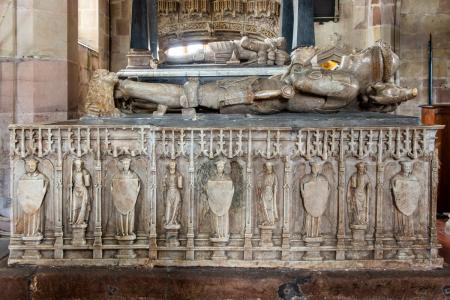
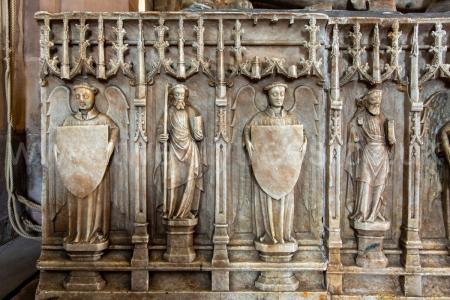
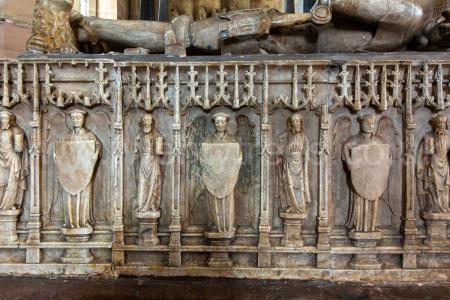
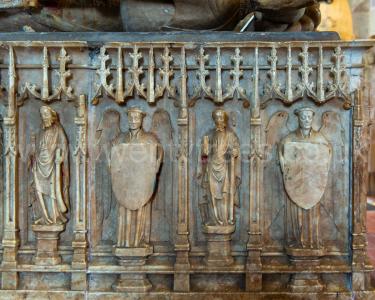
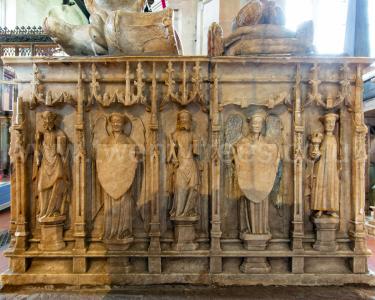
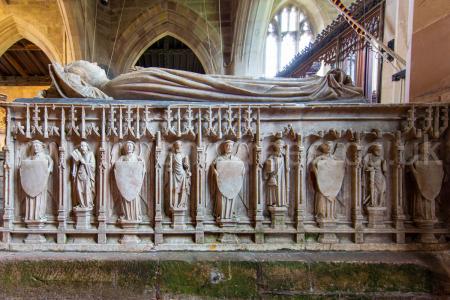
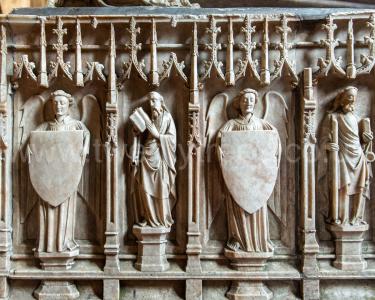
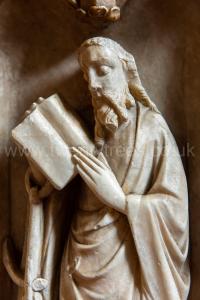
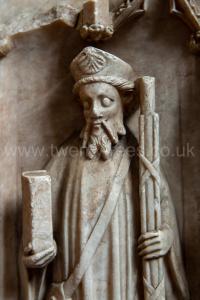
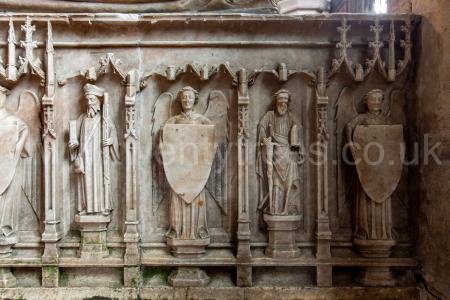
Around 1456 John Curzon (age 76) died. Monument in All Saints Church, Kedleston [Map] to John Curzon (age 76) and Joan Bagot (age 56). Fluted Period. Eagle Crest. Lancastrian Esses Collar. Couters. Pauldrons. Sabatons. Dogs chewing at her dress with Studded Collar. Probably Harpur and Moorecock of Burton on Trent.
John Curzon:
Around 1380 he was born to Richard Curzon at Kedleston.
Before 1412 John Curzon and Joan Bagot were married. The difference in their ages was 20 years.
Joan Bagot: Around 1400 she was born to John Bagot and Beatrice Mallory.
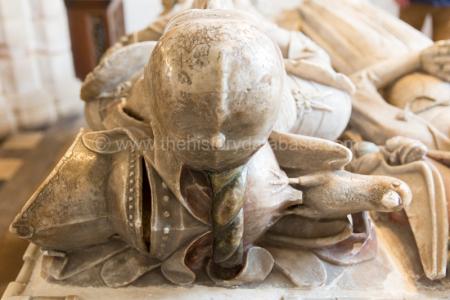
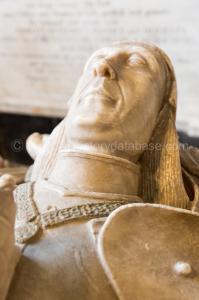
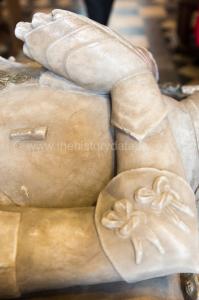
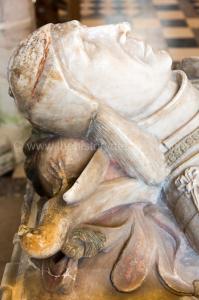
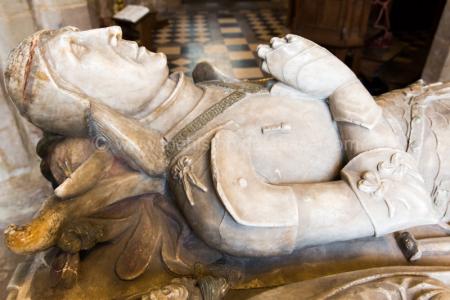
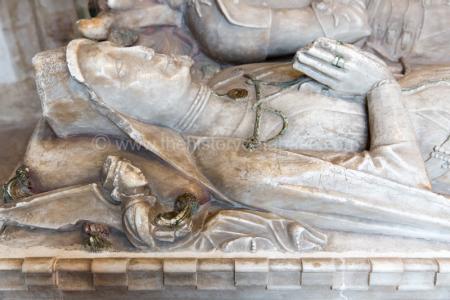
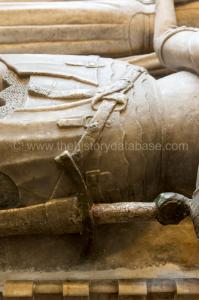
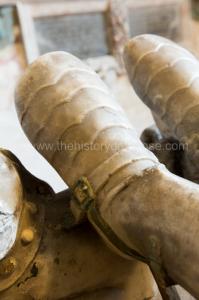
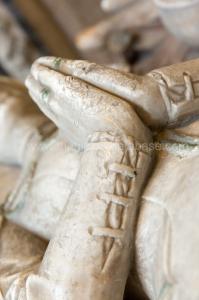
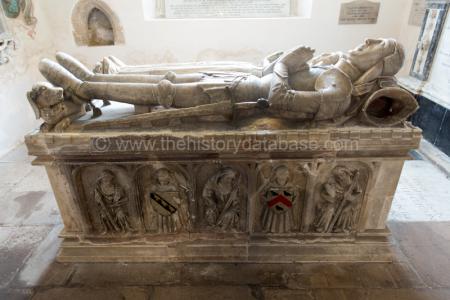
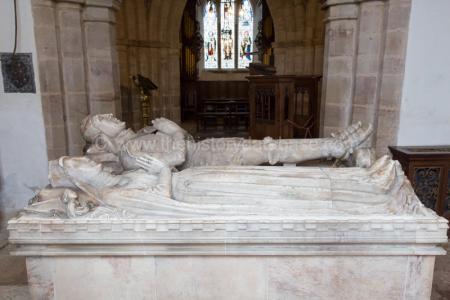
After 1456. St Lawrence's Church, Over Peover [Map]. Monument to Randle Mainwaring of Over Peover (deceased) and Margery Venables (age 87). Early Plate Bascinet and Gorget Period. He with a Lancastrian Esses Collar and IHC NASARE Lettering his head resting on an Ass's Head Crest. She wearing a mitred crespine headress. Possiby Sutton and Prentys.
Randle Mainwaring of Over Peover: Around 1363 he was born to William "The Elder" IV Mainwaring. Before 1390 Randle Mainwaring of Over Peover and Catherine Harcourt were married. She a great x 5 granddaughter of King Henry "Curtmantle" II of England. In 1391 Randle Mainwaring of Over Peover and Margery Venables were married at Kinderton Middleton. In 1456 Randle Mainwaring of Over Peover died.
Margery Venables: Around 1369 she was born to Hugh Venables of Kinderton. Around 1387 Richard Bulkeley and she were married. In 1459 Margery Venables died.
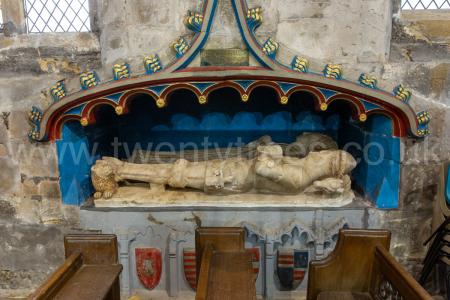
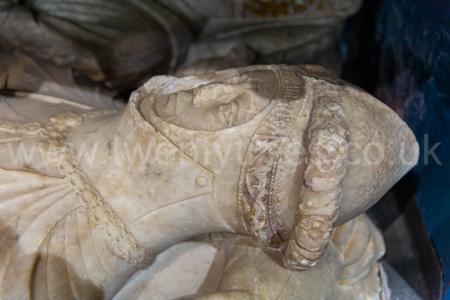
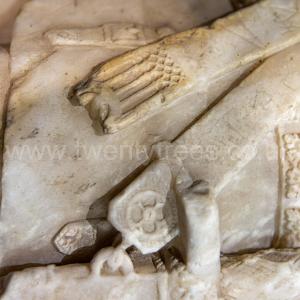
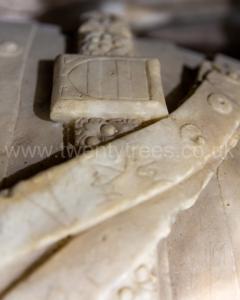
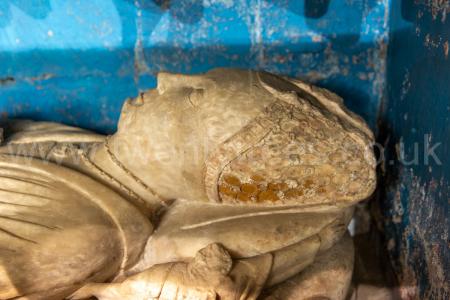
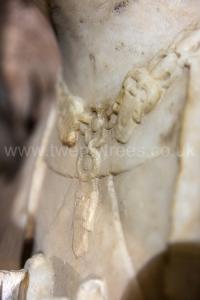
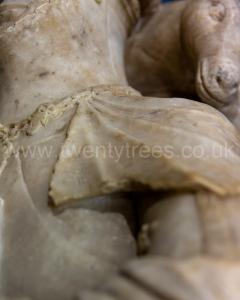
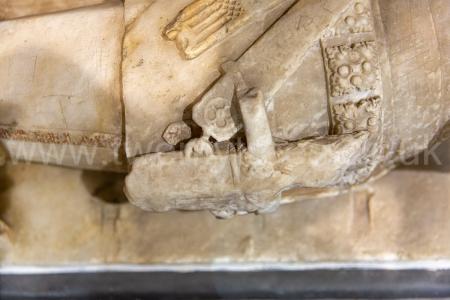
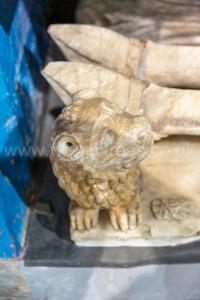
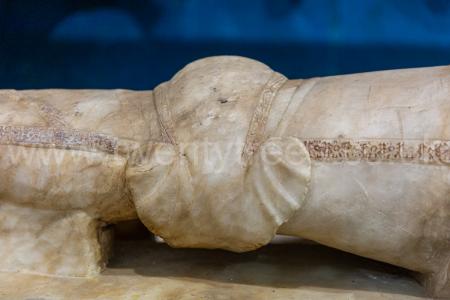
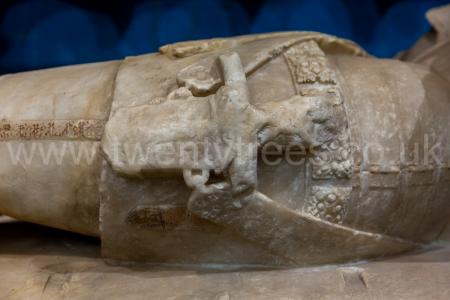
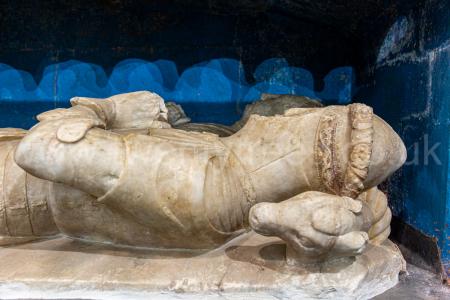
After 1459. Salisbury Cathedral [Map]. Monument to Robert Hungerford 2nd Baron Hungerford (deceased). Fluted Period. Lancastrian Esses Collar.
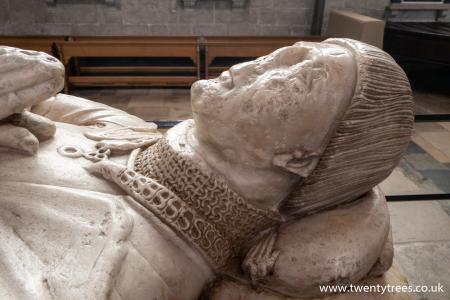
Around 1470. St Helen's Church Ashby-de-la-Zouch, Leicestershire [Map]. Believed to be Thomas Hastings otherwise a Pilgrim unusual for wearing and Lancastrian Esses Collar.
Thomas Hastings: he was born to Leonard Hastings and Alice Camoys.
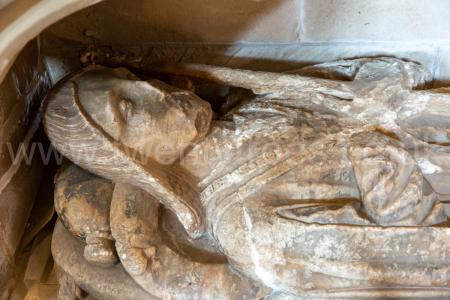
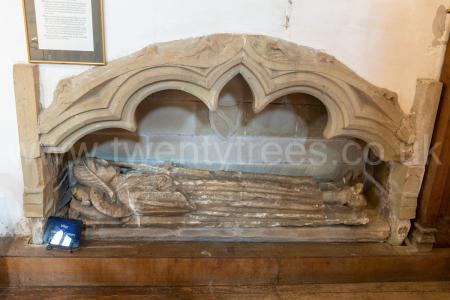
On 12 Mar 1487 William Gascoigne (age 35) died at Gawthorpe Hall [Map]. All Saints Church Harewood [Map]. Monument to William Gascoigne (age 35) and Margaret Percy (age 40). Fluted Period. Alabaster chest tomb with a fine array of weepers, possibly their children although too many, women one side, nine men the other, one of which appears with angels wings, possible children and spouses. He wearing a Lancastrian Esses Collar with unusual O links. Clean shaved, no bascinet, his head resting on a helm with bulls head crest. His armour plate over which there appears to be, unusually for the period, a tabard. The left hand side of his face appears disfigured. Possibly a war wound. She wearing the widow's barbe. Note. Gardner describes this monument as being to Sir John Nevill of Womersley, died 1482. Chest with Weepers. Chest with Angels with Rounded Wings holding Shields. Angels Supporting Pillow.
William Gascoigne:
Around 1452 he was born to William Gascoigne XIII and Joan Neville at Gawthorpe Hall.
Before 1467 William Gascoigne and Margaret Percy were married. She the daughter of Henry Percy 3rd Earl of Northumberland and Eleanor Poynings Countess Northumberland. They were half second cousin once removed. He a great x 4 grandson of King Edward III of England. She a great x 3 granddaughter of King Edward III of England.  In 1478 he was appointed Knight of the Bath.
In 1480 William Gascoigne received a license to crenellate at Gawthorpe Hall.
In 1478 he was appointed Knight of the Bath.
In 1480 William Gascoigne received a license to crenellate at Gawthorpe Hall.
Margaret Percy: Around 1447 she was born to Henry Percy 3rd Earl of Northumberland and Eleanor Poynings Countess Northumberland. She a great x 3 granddaughter of King Edward III of England.
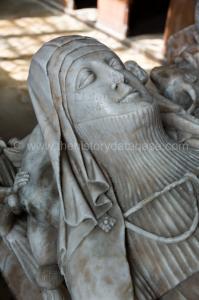
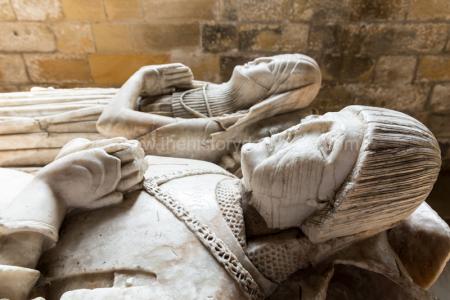
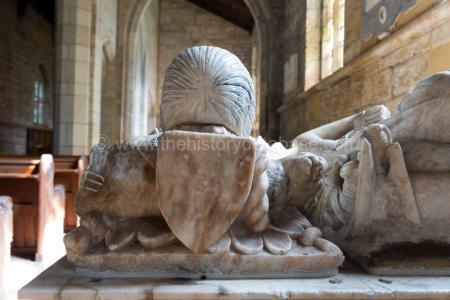
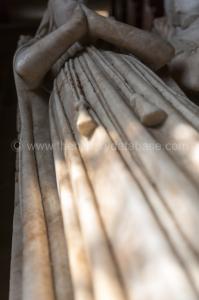
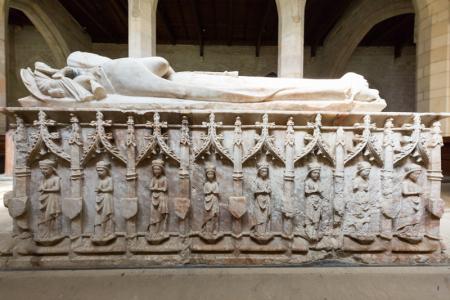
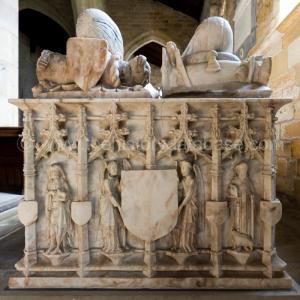
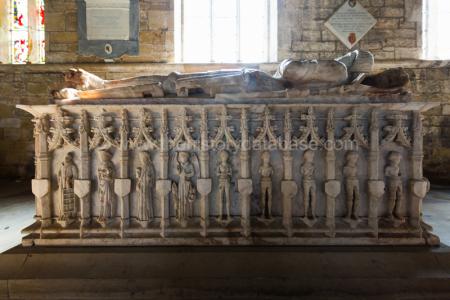
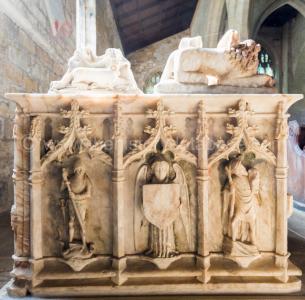
After 29 May 1495. Monument to Thomas Fitzwilliam (deceased) and Lucy Neville (age 27) in St Mary's Church Tickhill Doncaster [Map]. Originally located in Tickhill Friary the tomb was moved to St Mary's Church at the Dissolution in 1538. Restored in 2012. The alabaster chest tomb believed to be one of the earliest examples of Italianate carving. The Lancastrian Esses Collar highly unusual; unique even but then so is the armour.

Thomas Fitzwilliam: On 13 Jan 1448 he was born to Richard Fitzwilliam in Aldwark. Around 1473 Thomas Fitzwilliam and Lucy Neville were married. She the daughter of John Neville 1st Marquess Montagu and Isabel Ingaldsthorpe. She a great x 3 granddaughter of King Edward III of England. On 29 May 1495 Thomas Fitzwilliam died.
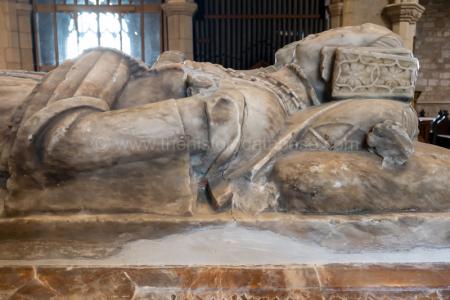
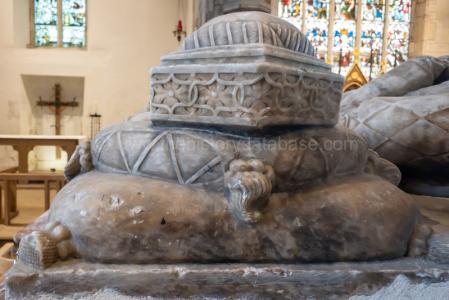
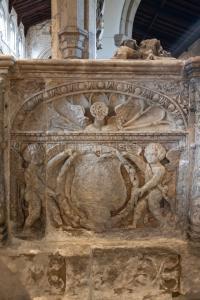
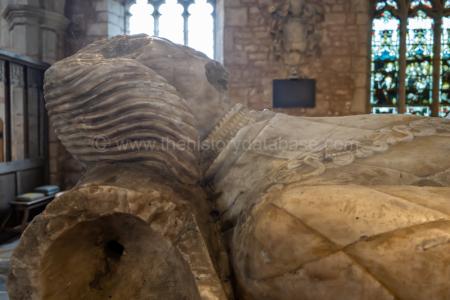
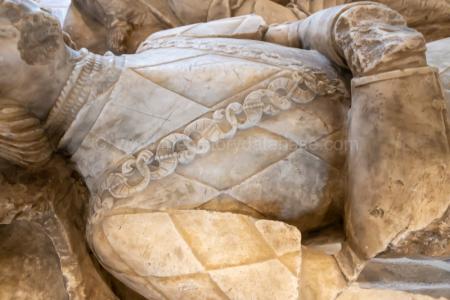
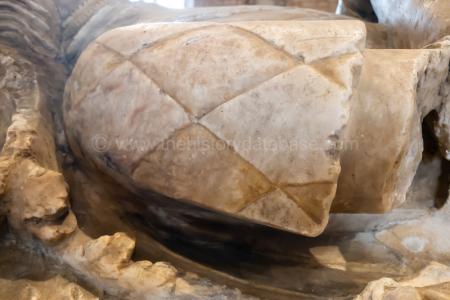
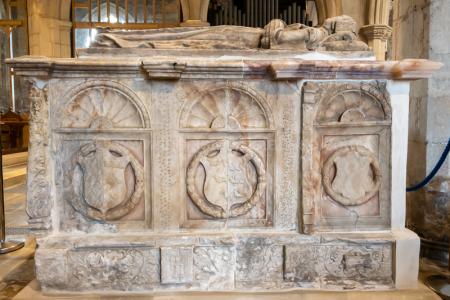
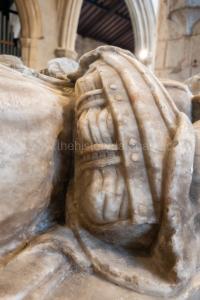
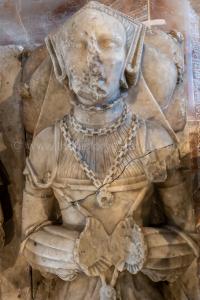
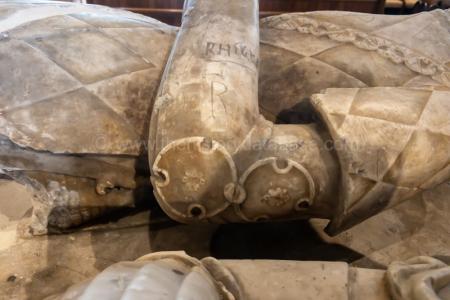
On 30 May 1499 John Cheney 1st Baron Cheyne (age 57) died. Fluted Period. Alabaster Monument at Salisbury Cathedral [Map].
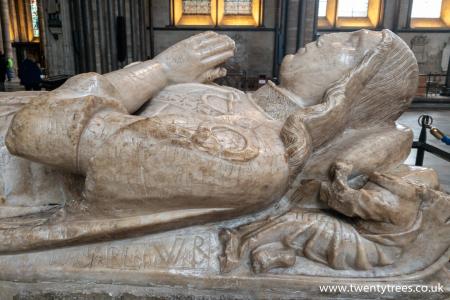
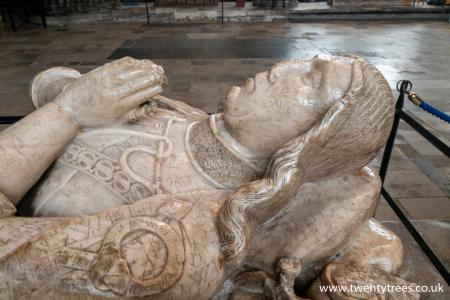 Fluted armour typified by having no headwear, being clean shaven, a breastplate in two pieces and the neck protected by a Standard. Damaged angel, its head removed, holding the cushion on which his head rests. He wearing a Lancastrian Esses Collar with large Esses. Ringed fingers.
Fluted armour typified by having no headwear, being clean shaven, a breastplate in two pieces and the neck protected by a Standard. Damaged angel, its head removed, holding the cushion on which his head rests. He wearing a Lancastrian Esses Collar with large Esses. Ringed fingers.
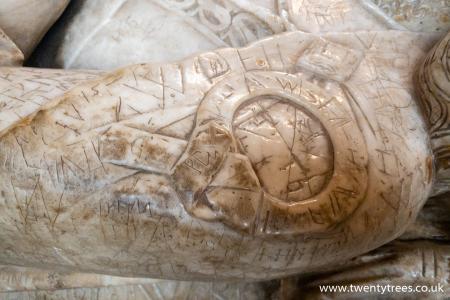 Detail of the heavily graffitied Shoulder Garter.
Detail of the heavily graffitied Shoulder Garter.
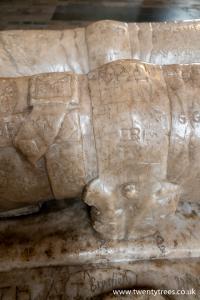 Detail of the heavily graffitied Leg Garter and Poleyn.
Detail of the heavily graffitied Leg Garter and Poleyn.
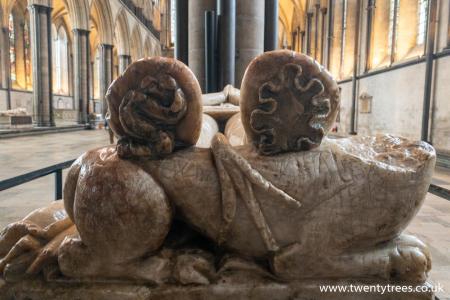 Mutilated Lion at his feet with its head missing. The figure beneath his right foot appears to be a Bedesman. That beneath his left foot may be the remains of the means by which a bedesman was originally fixed to the foot. What appears to be a birds foot lying across the lions body is the tail of the lion.
Mutilated Lion at his feet with its head missing. The figure beneath his right foot appears to be a Bedesman. That beneath his left foot may be the remains of the means by which a bedesman was originally fixed to the foot. What appears to be a birds foot lying across the lions body is the tail of the lion.
After 1517. St Bartholemew's Church, Tong [Map]. Monument to Richard Vernon (age 40) and Margaret Dymoke (age 17). Fluted Period. Angels Supporting Pillow. The alabaster chest was once used as the altar. He with an Lancastrian Esses Collar and Tudor Rose Pendant. Chest with Bedesmen. Note the swirling tail at his feet which may indicate the work of Harpur and Moorecock of Burton on Trent.

Richard Vernon:
Around 1477 he was born to Henry Vernon and Anne Talbot.
In or before 1508 Richard Vernon and Margaret Dymoke were married. The difference in their ages was 23 years.
 In Aug 1517 Richard Vernon died. He was buried at St Bartholemew's Church, Tong.
In Aug 1517 Richard Vernon died. He was buried at St Bartholemew's Church, Tong.
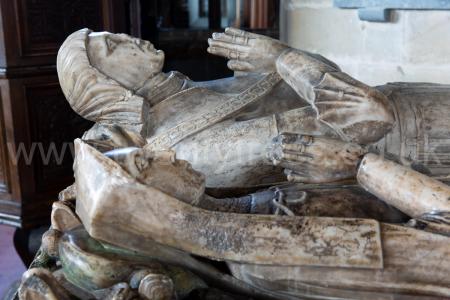
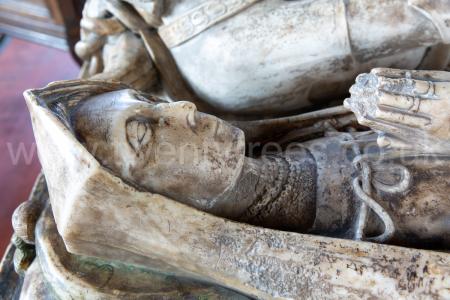
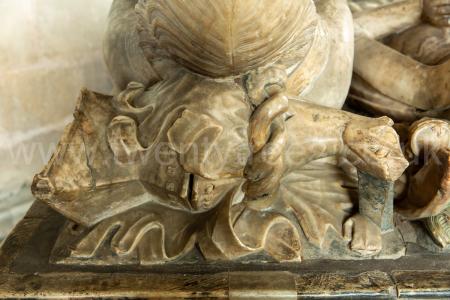
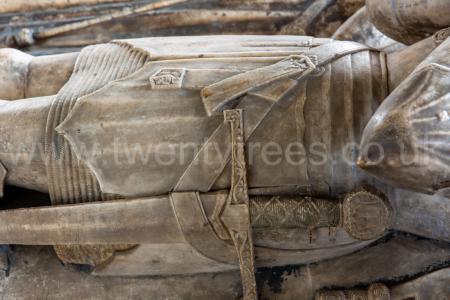
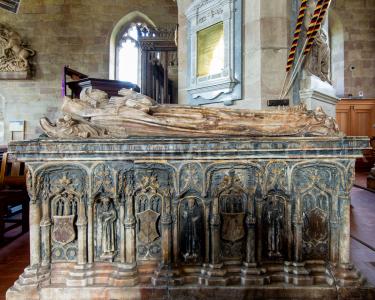
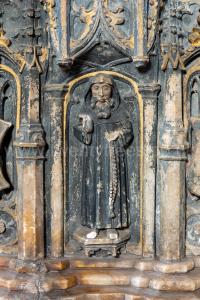
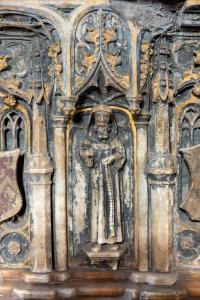
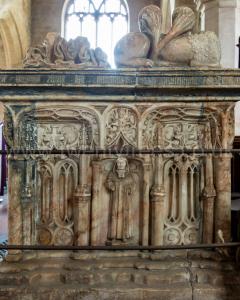
In or after 1526. St Mary's Church, Ruabon [Map]. Monument [Map] to John ap Ellis Eyton. Alabaster Monument. Lancastrian Esses Collar. Possibly Harpur and Moorecock of Burton on Trent.
John ap Ellis Eyton: In 1526 he died.
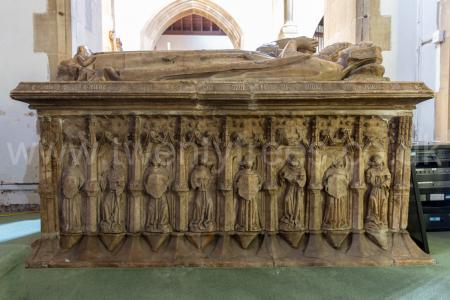
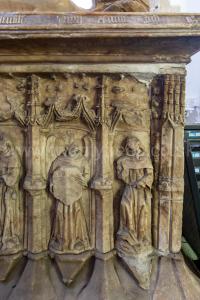 Chest with Angels with Rounded Wings holding Shields indicative of Harpur and Moorecock of Burton on Trent.
Chest with Angels with Rounded Wings holding Shields indicative of Harpur and Moorecock of Burton on Trent.
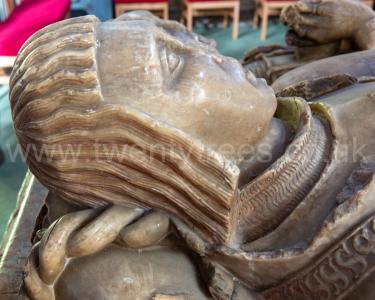 Detail of his head. Categorised as Fluted Period. Note the absence of headwear, his being clean shaven and the Standard protecting the neck all of which define the Fluted Period.
Detail of his head. Categorised as Fluted Period. Note the absence of headwear, his being clean shaven and the Standard protecting the neck all of which define the Fluted Period.
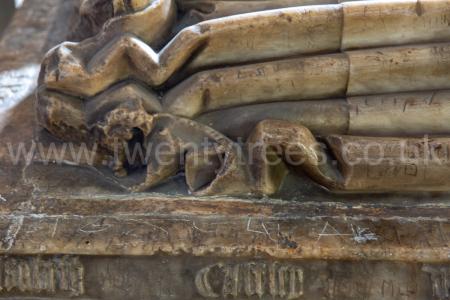 Before it was damaged this was a dog chewing at the hem of her dress; also indicative of Harpur and Moorecock of Burton on Trent.
Before it was damaged this was a dog chewing at the hem of her dress; also indicative of Harpur and Moorecock of Burton on Trent.
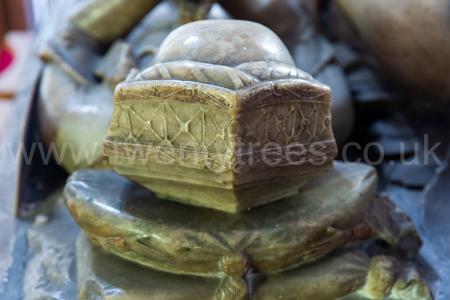
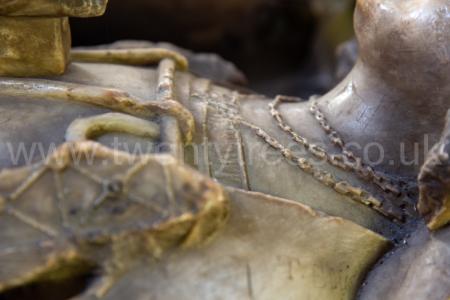
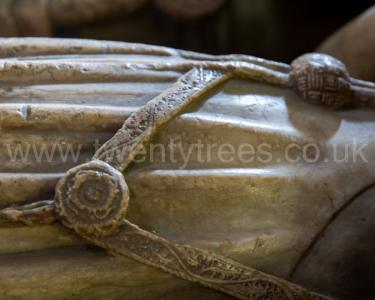
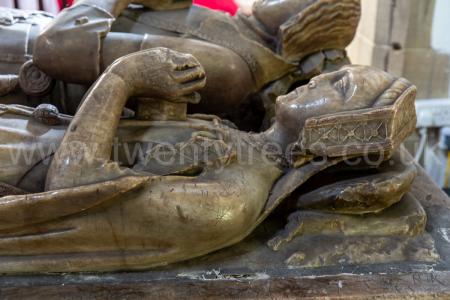 She wearing a Gabled Headress.
She wearing a Gabled Headress.
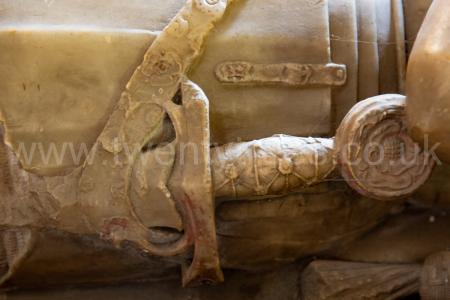 Tudor Roses on his sword pommel.
Tudor Roses on his sword pommel.
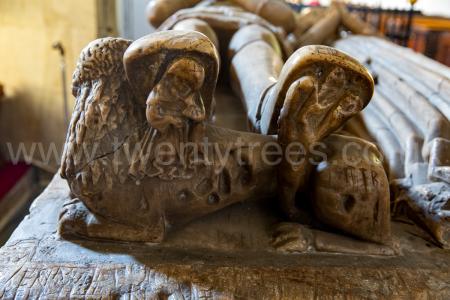 Bedesman and Swirling Tail both indicative of Harpur and Moorecock of Burton on Trent.
Bedesman and Swirling Tail both indicative of Harpur and Moorecock of Burton on Trent.
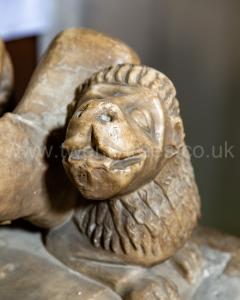 A curious lion at his feet. Unlikely the carver had ever seen a lion.
A curious lion at his feet. Unlikely the carver had ever seen a lion.
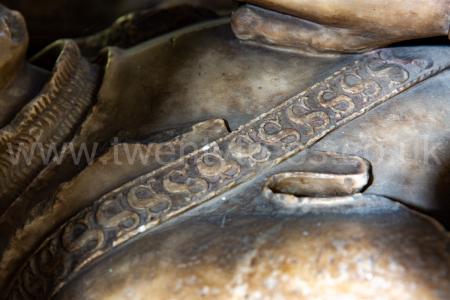 Lancastrian Esses Collar.
Lancastrian Esses Collar.
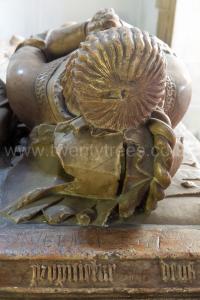
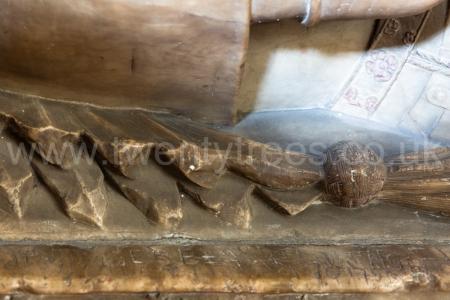
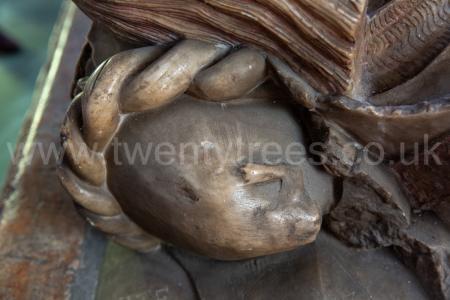 Detail of the orle, mantling and what remains of the crest on his Great Helm. Difficult to tell what it was originally.
Detail of the orle, mantling and what remains of the crest on his Great Helm. Difficult to tell what it was originally.
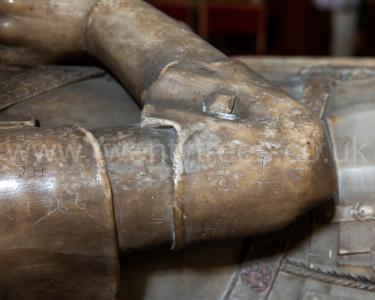
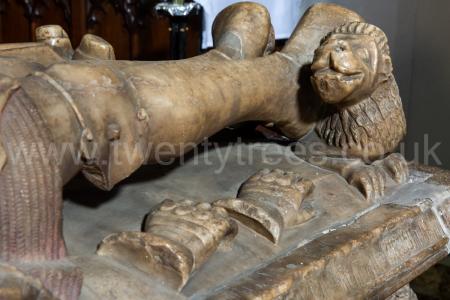
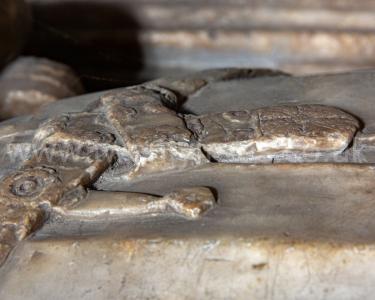
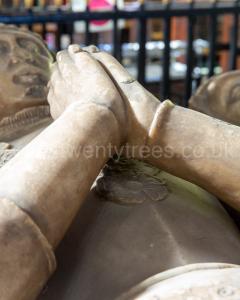
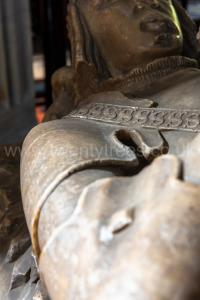
In 1528 Henry Willoughby (age 77) was buried at St Leonard's Church Wollaton, Nottinghamshire [Map]. A fine chest tomb monument in sandstone (rather than alabaster), somewhat damaged, with his four wives, two each side.Lancastrian Esses Collar somehwat unusual given the 1528 date of his death. Sphinx Crest. Cadaver Underneath. Henry Willoughby's Arms including Willoughby top left hand corner (Water Bougets from Willoughy family original name Bugge). Lancastrian Esses and Inter-twined Knots Collar.
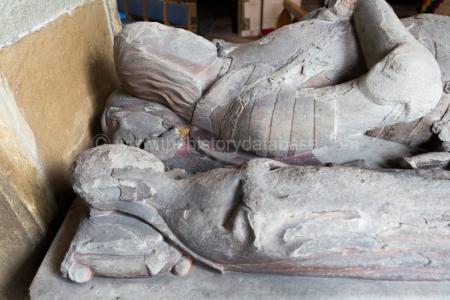
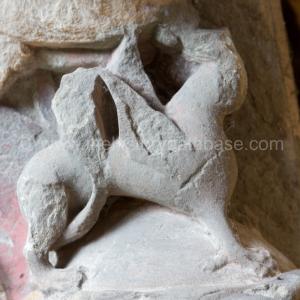
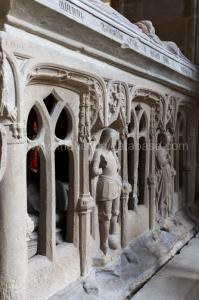
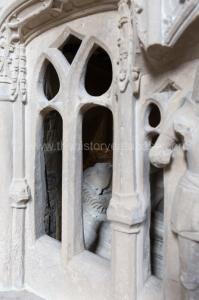
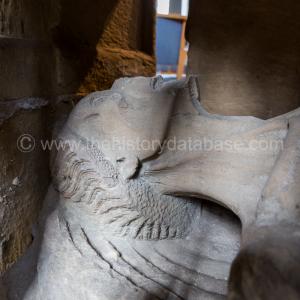
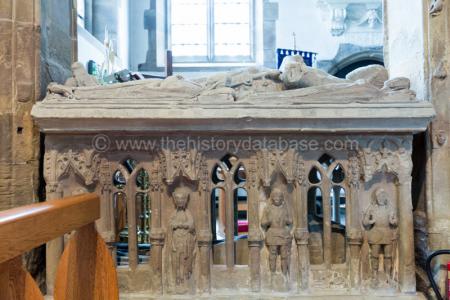
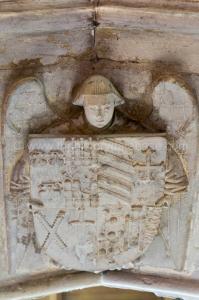
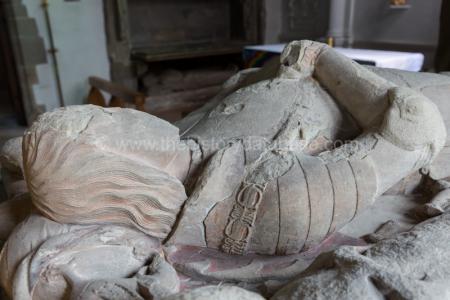
Hall's Chronicle 1533. 19 May 1533. The coming by water from Greenwich the Thursday.
The ninetteeth day of May the Mayor and his brethren all in Scarlet, and such as were knights had collars of Esses and the remnant having good chains, and the counsel of the city with them assembled at saint Mary Hill, and at one of the clock descended to the New Stair to their barge, which was garnished with many goodly banners and streamers, and richly covered. In which barge were Shalmes, Shagbushes and diverse other instruments, which continually made goodly harmony. After that the Mayor and his brethren were in their barge seeing that all the companies to the number of fifty barges were ready to wait upon them. They gave commandment to the companies that no barge should row nearer to another then twice the length of the barge upon a great pain. And to see the order kept, there were three light wherys prepared, and in every one of them two officers to call on them to keep their order, after which commandment given they set forth in order as hereafter is described.
First before the Mayors barge was a Foyst or Wafter full of ordinance, in which Foyst was a great Dragon continually moving, and casting wildfire, and round about the said Foyst stood terrible monsters and wild men casting fire and making hideous noises: Next after the Foyst a good distance came the Mayors barge, on whose right hand was the Batchelors barge, in the which were trumpets and diverse other melodious instruments. The decks of the said barge and the sailyards and the top castles were hanged with rich cloth of gold and silk. At the foreship and the Stern were two great banners rich beaten with the arms of the king and the queen, and on the top castle also was a long streamer newly beaten with the said arms. The sides of the barge were set full of Flags and banners of the devises of the company of Haberdashers and merchant adventurers, and the cords were hanged with innumerable pensels having little bells at the ends which made a goodly noise and a goodly sight wavering in the wind. On the outside of the barge were three dozen Escutcheons in metal of arms of the king and the Queen which were beaten upon square bucram divided so that the right side had the King's colours, and the left side the Queen's, which Escutcheons were fastened on the clothes of gold and silver hanging on the decks on the left hand. On the left hand of the Mayor was another Foyst, in the which was a mount and on the same stood a white Falcon crowned upon a rote of gold environed with white roses and red, which was the Queens devise: about which mount sat virgins singing and playing sweetly. Next after the Mayor followed his fellowship the Haberdashers. Next after them the Mercers, then the Grocers, and so every company in his order, and last of all the Mayors and sheriff's officers, every company having melody in his barge by himself, and goodly garnished with banners and some garnished with silk and some with Arras and rich carpets, which was a goodly sight to behold, and in this order they rowed to Greenwich to the point next beyond Greenwich, and there they turned backward in another order, that is to wete, the Mayor and Sheriff's officers first, and the meanest craft next, and so ascending to the uttermost crafts in order and the Maior last as they go to Paul's at Christmas, and in that order they rowed downward to Greenwich town and there cast anchor making great melody. At three of the clock the Queen appeared in rich cloth of gold and entered into her barge accompanied with diverse ladies and gentlewomen, and incontinent the Citizens set forwards in their order, their minstrels continually playing, and the Batchelors barge going on the queen's right hand which she took great pleasure to behold. About the Queen's barge were many noble men, as the duke of Suffolk, the Marques Dorset, the Erie of Wiltshire, her father, the Earls of Arundel, Derby, Rutland, Worcester, Huntingdon, Sussex, Oxford, and many bishops and noblemen every one in his barge, which was a goodly sight to behold. She thus being accompanied rowed toward the Tower, and in the mean way the shippes which were commanded to lie on the shore for letting of the barges shot diverse peals of guns, and or she landed there was a marvellous shot out of the Tower as ever was heard there. And at her landing there met with her the Lord Chamberlain with the officers of arms and brought her to the King, which received her with loving countenance at the Posterne by the water side and kissed her, and then she turned back again and thanked the Mayor and the citizens with many goodly words, and so entered into the Tower. After which entry the citizens all this while housed before the Tower making great melody and went not aland, for none were assigned to land but the Mayor, the Recorder and two Aldermen. But for to speak of the people that stood on every shore to behold the sight, he that saw it not would not believe it.
After 1554. St Mary the Virgin Church, North Aston [Map]. Believed to be a. Monument to John Anne but the armour would suggest it is around a hundred years or so earlier than his death in 1554. Finely carved in alabaster. Early Plate Bascinet and Gorget Period. Lancastrian Esses Collar. Lion Pendant. Fine Bedesmen on the chest. Dogs chewing at her dress. Possibly Harpur and Moorecock of Burton on Trent. Angels Supporting Pillow. Chest with Weepers. Chest with Angels with Rounded Wings holding Shields. Gabled Headress with Lappets.
John Anne: In 1554 he died.
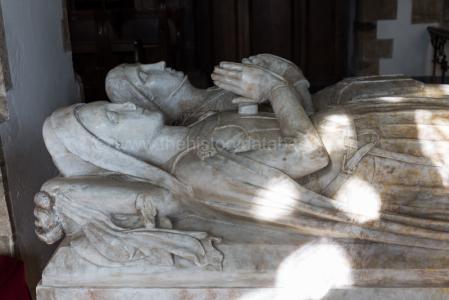
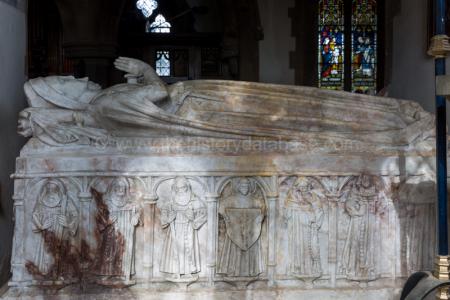
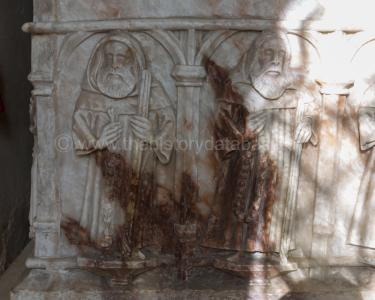
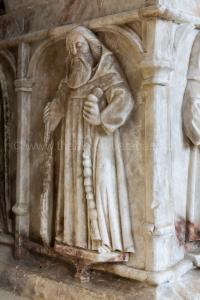
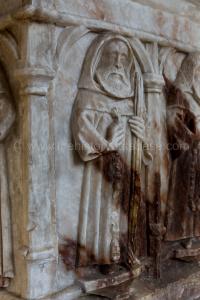
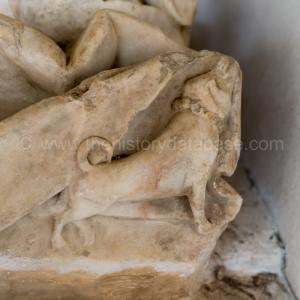
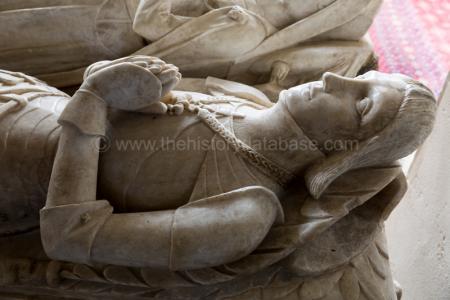
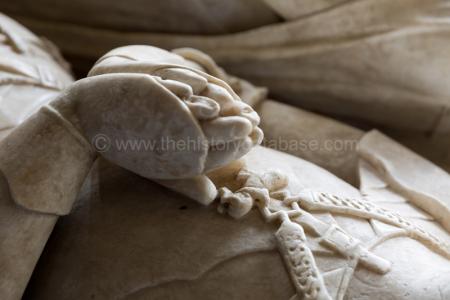
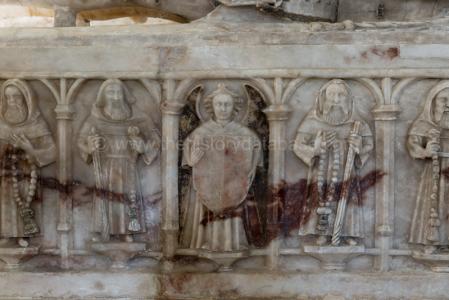
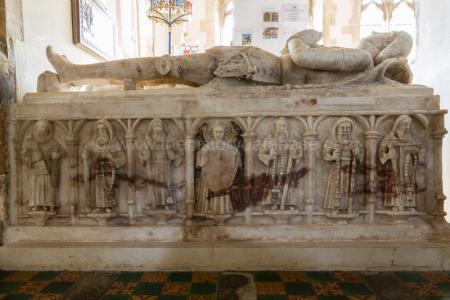
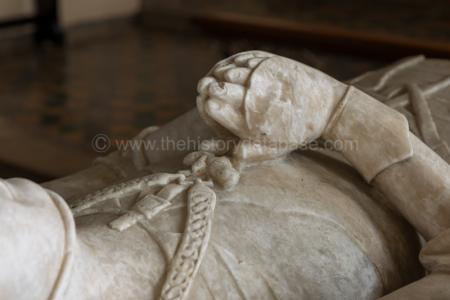
Introduction. Often when a monument was so disfigured as, to the eye of any ordinary observer, to appear hopeless as the subject for a drawing, would Mr. Stothard, by industriously stripping it, by means of a penknife, of its barbarous coat of whitewash, or other plastering (called by country churchwardens beautifying restore the sharpness of the parts, and produce a drawing replete with the finest minutiae of detail. Never was there an eye more accurately observant of the characteristic points of art in different ages than Mr. Stothard's. Not a fragment of painted glass, or tile decorated by any sort of ornament, but be could assign to it a proper era. This lion rampant was of the manner adopted in blazoning heraldic bearings in the reign of the First Edward; the ornament on that belt was of the Third; the mitre on the head of a certain Bishop was of Henry the Third's time; the style of such a capital bespoke a coeval date. The original conjecture that the collar of SS. expressed Henry the Fourth's favourite motto, was one instance of his critical acumen; and a good proof that his solution of the enigma was right, is, that some antiquaries have since unhesitatingly adopted it as their own:—an observation which might be extended to the piracies which have been committed on his monumental etchings; for such they become, when his drawings have been copied without even the courtesy of acknowledgment.